International Energy Outlook 2019 with projections to 2050
























































































































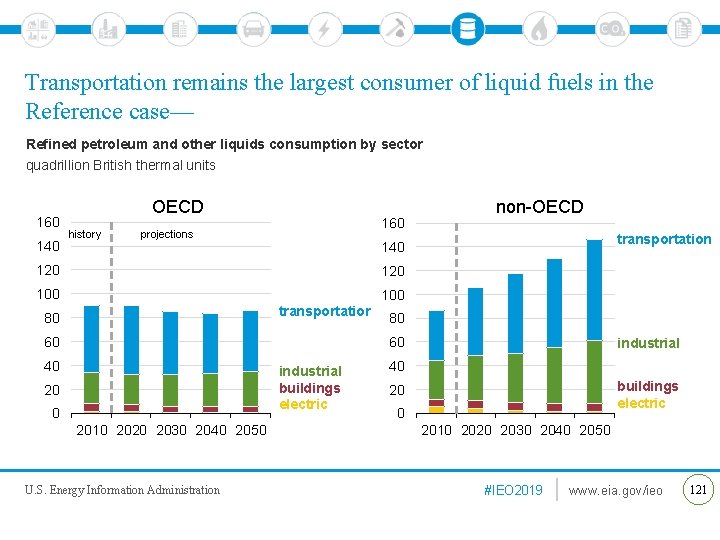
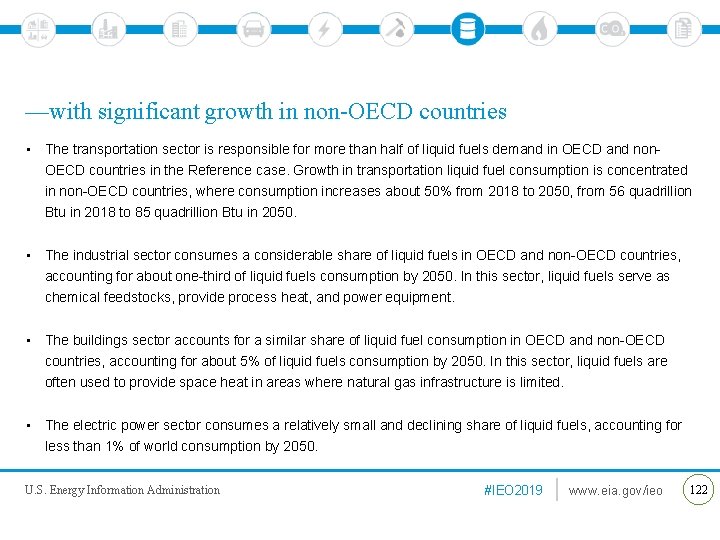
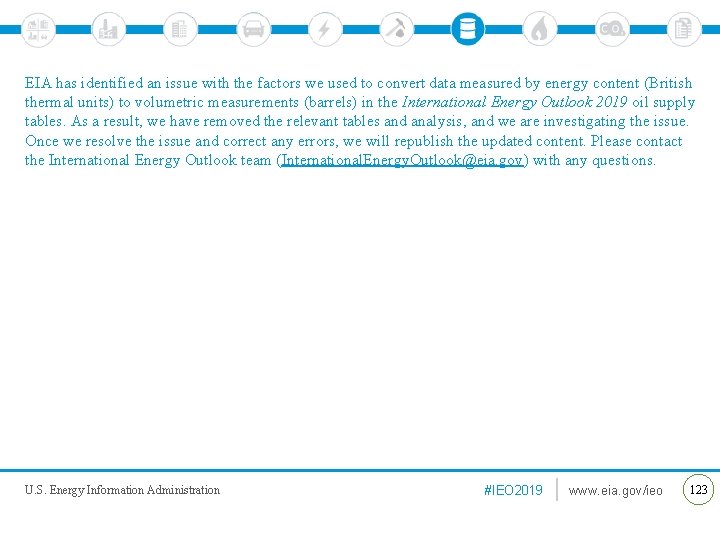
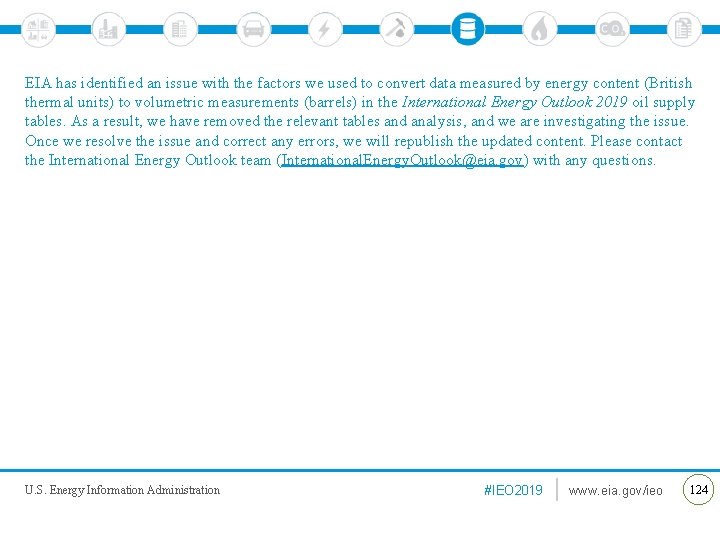
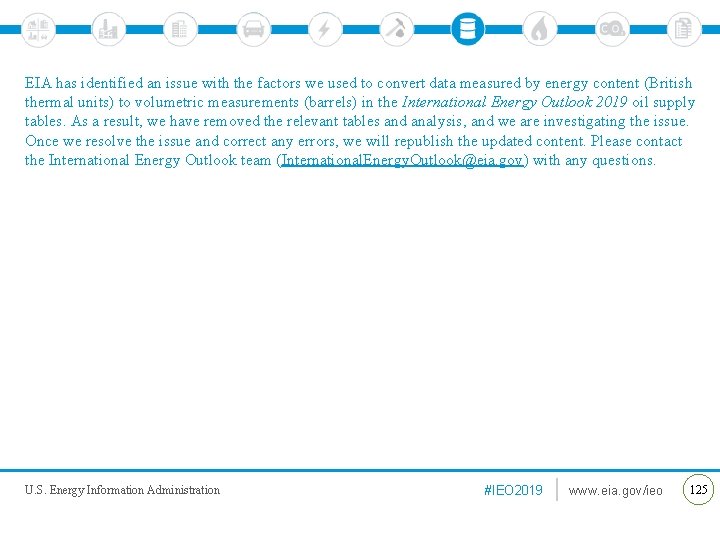
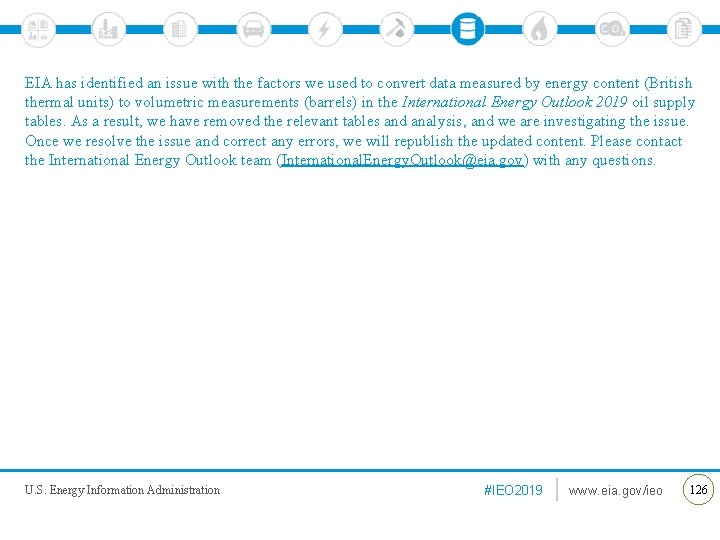
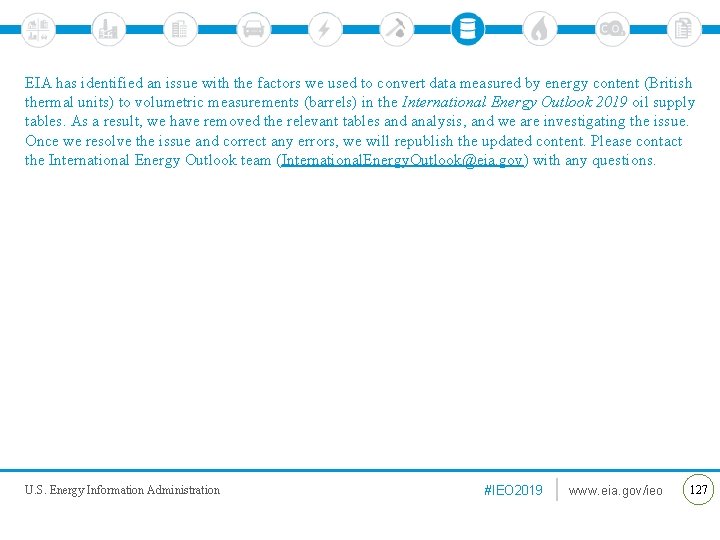
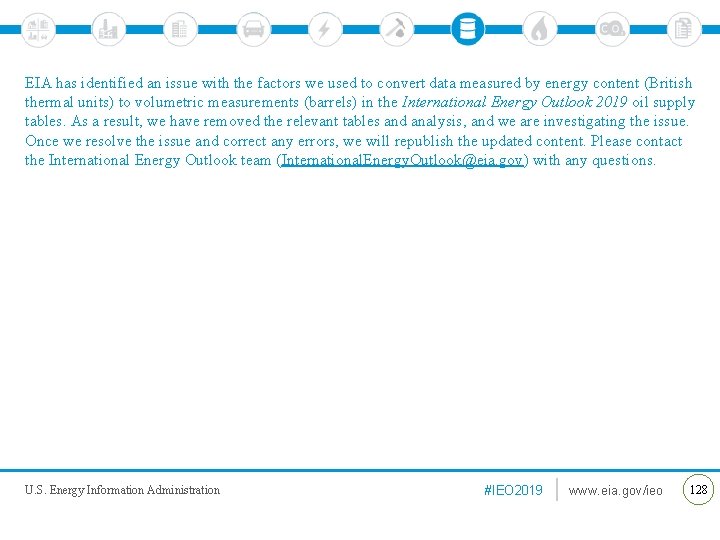
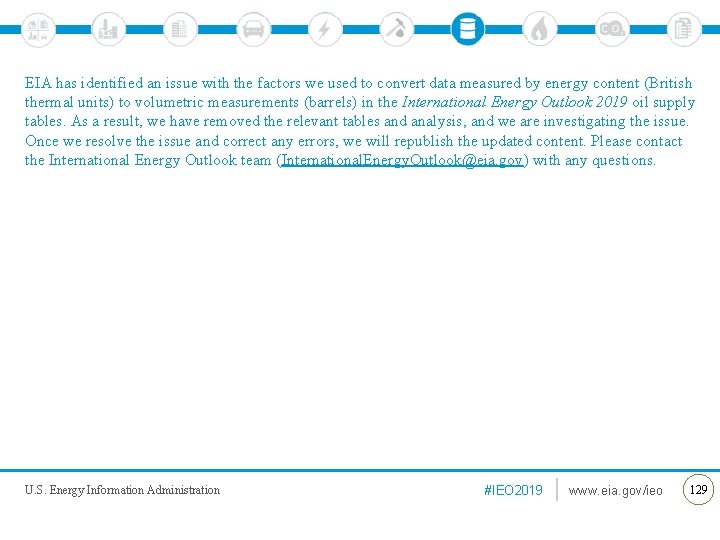
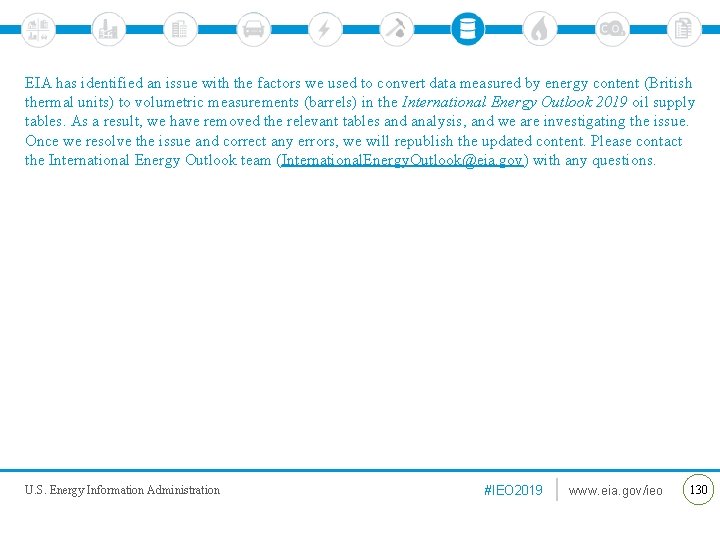
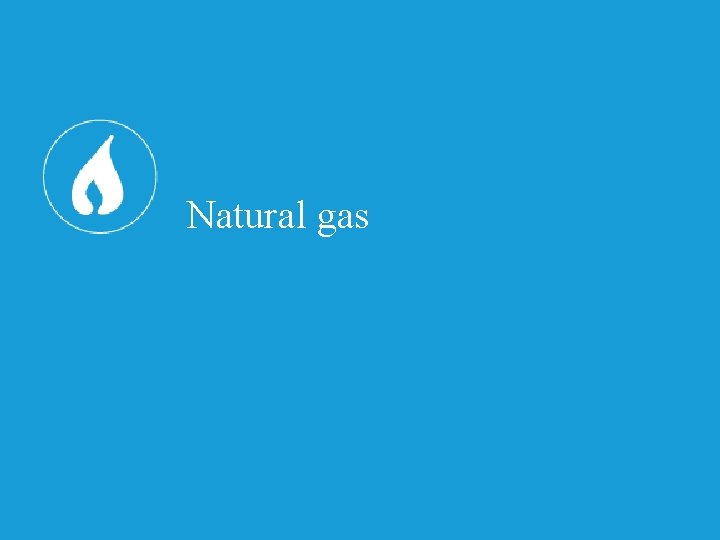

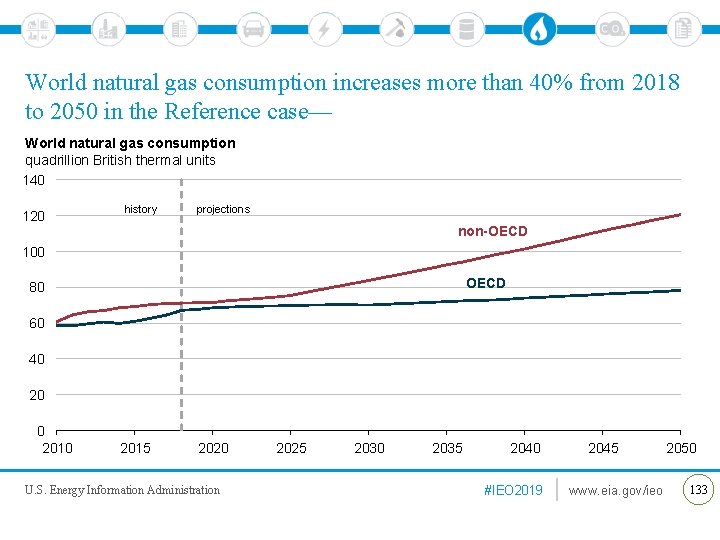
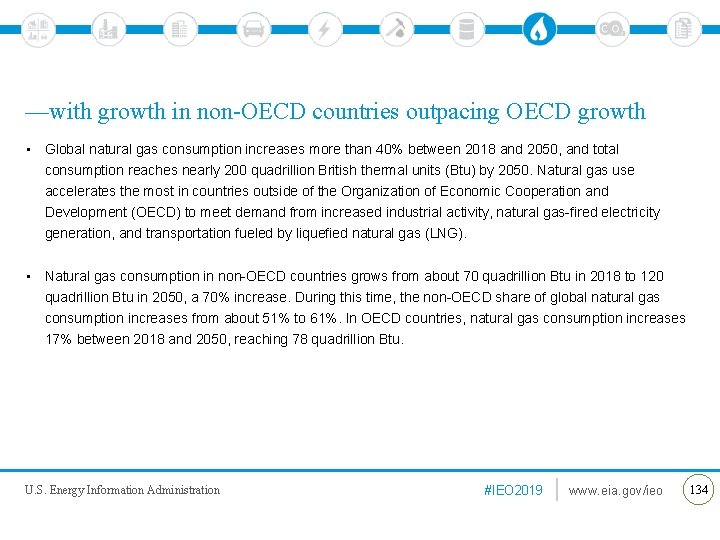
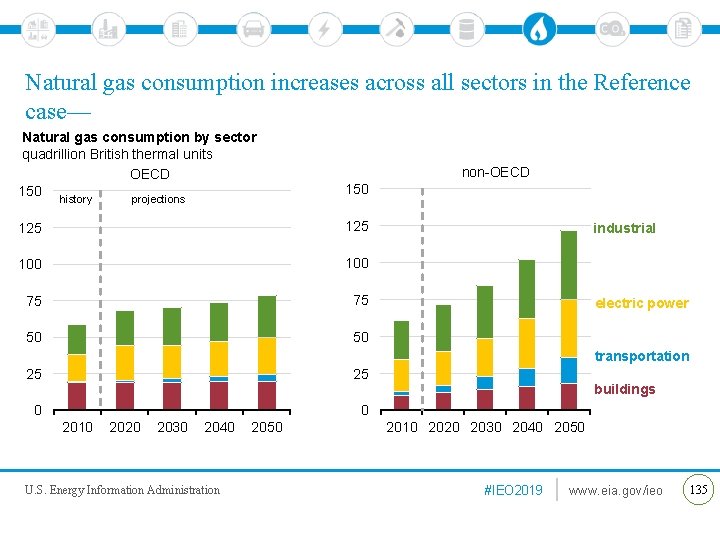
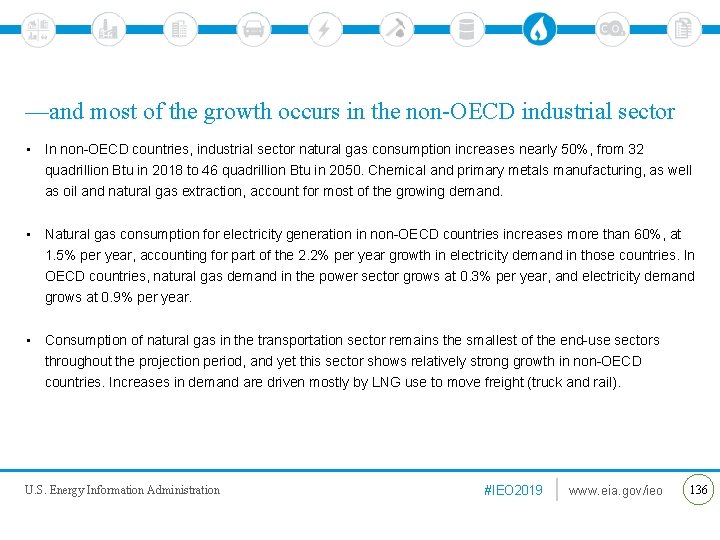
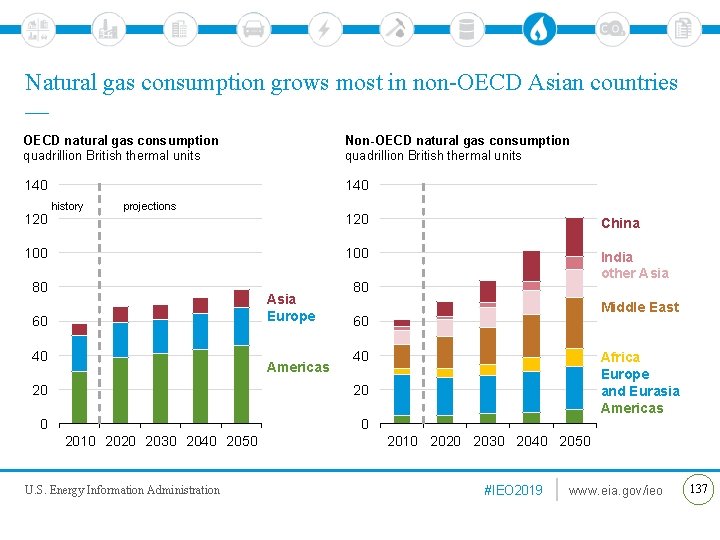
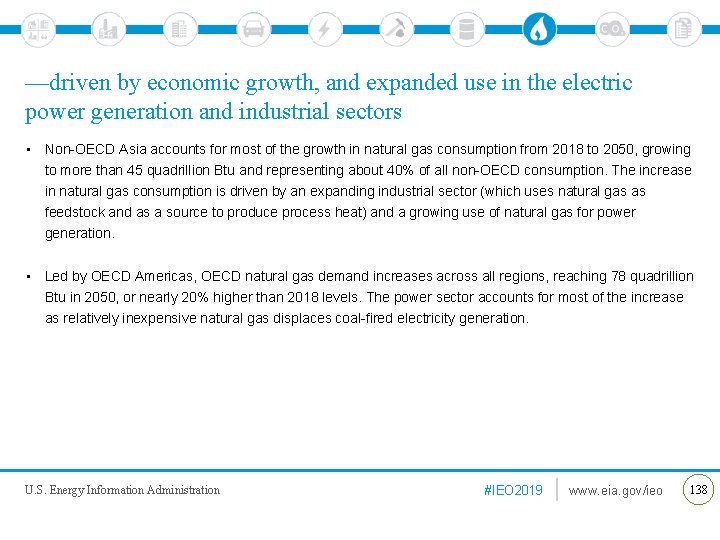
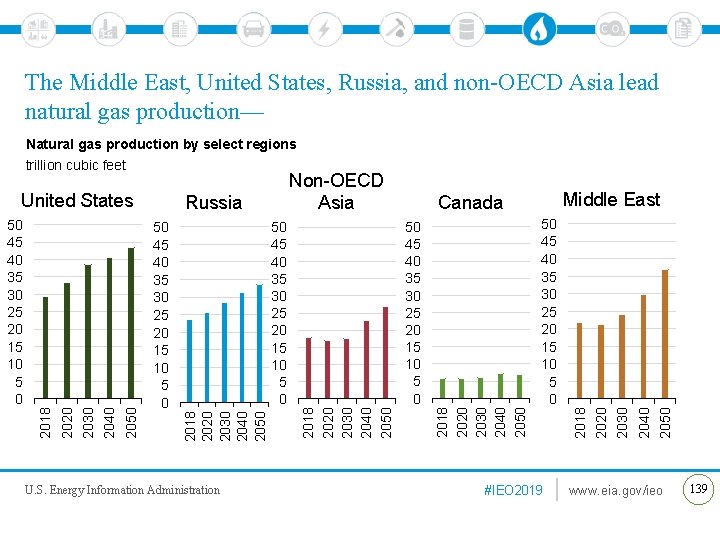
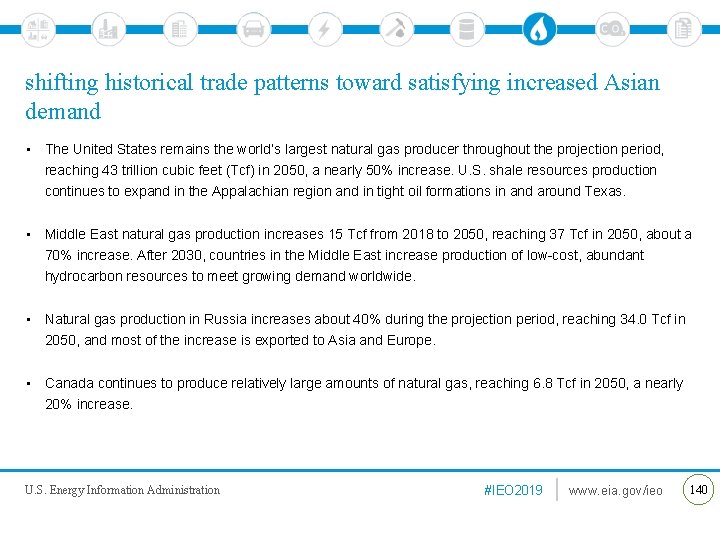

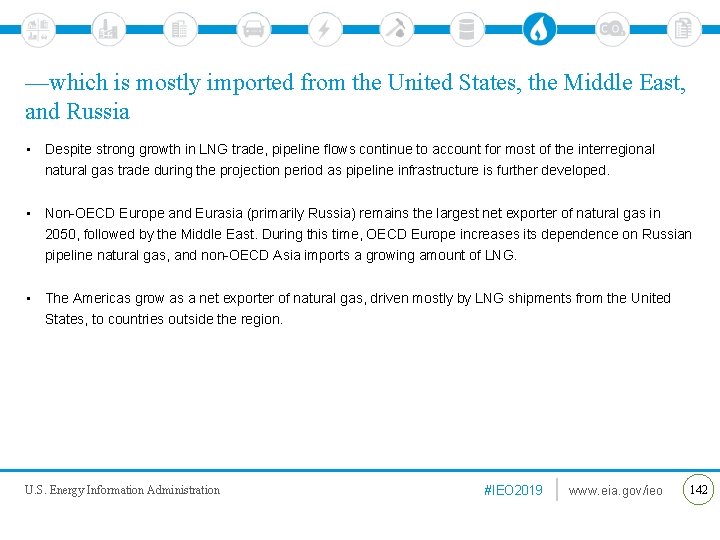
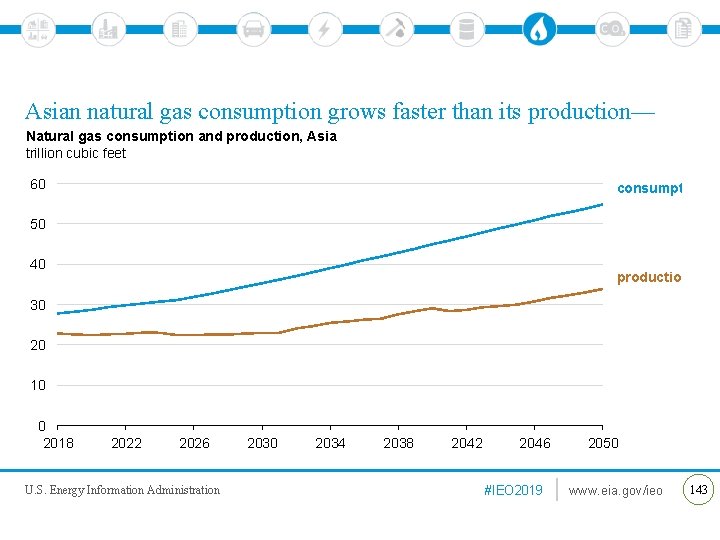
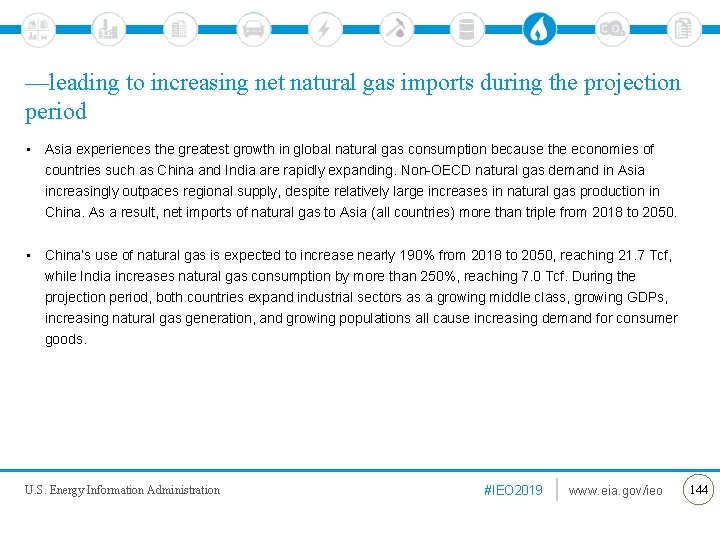
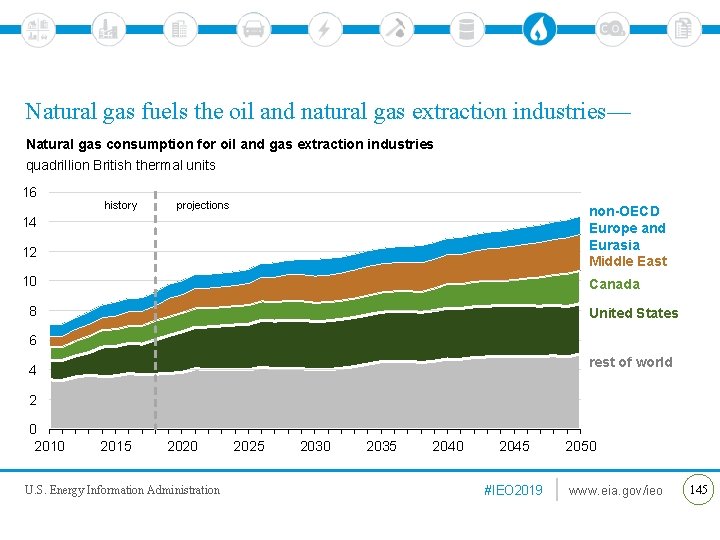
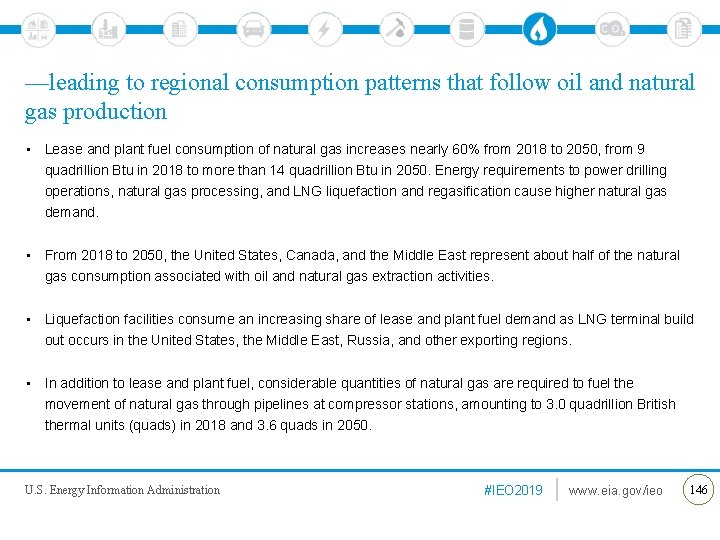
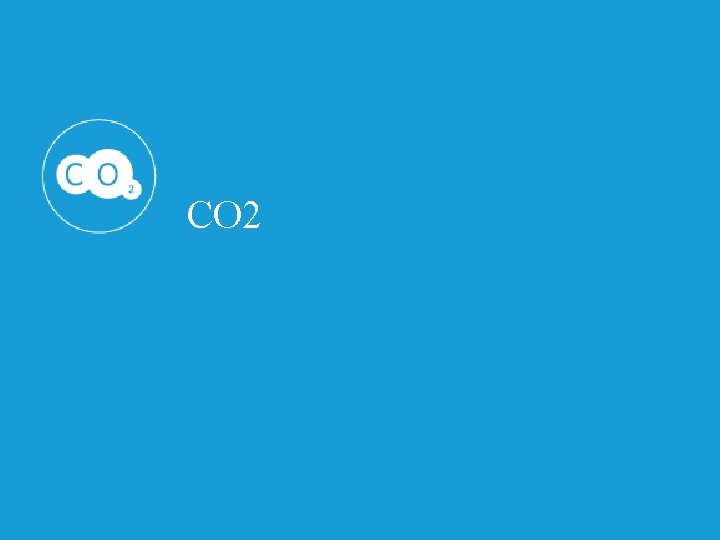

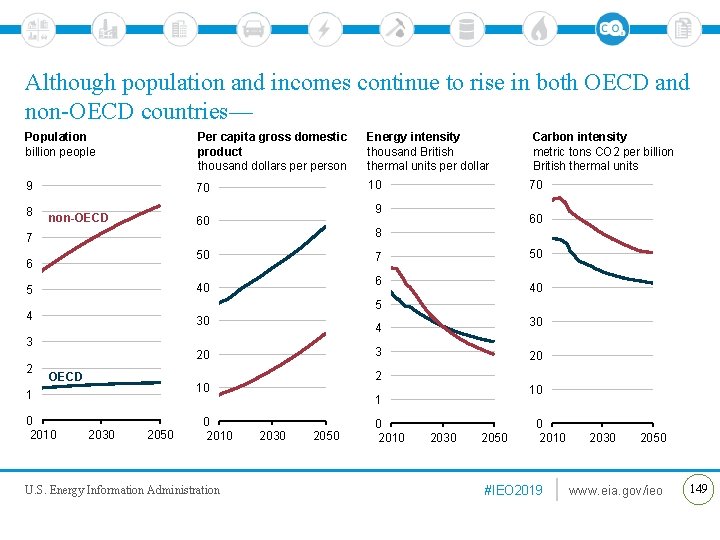
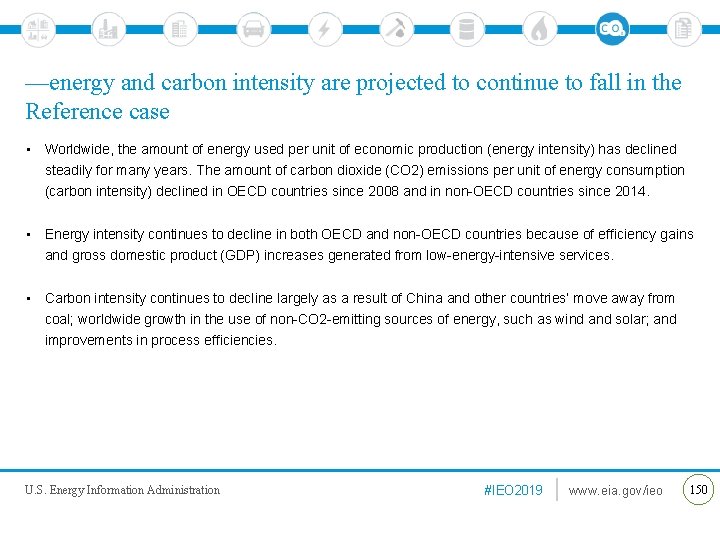
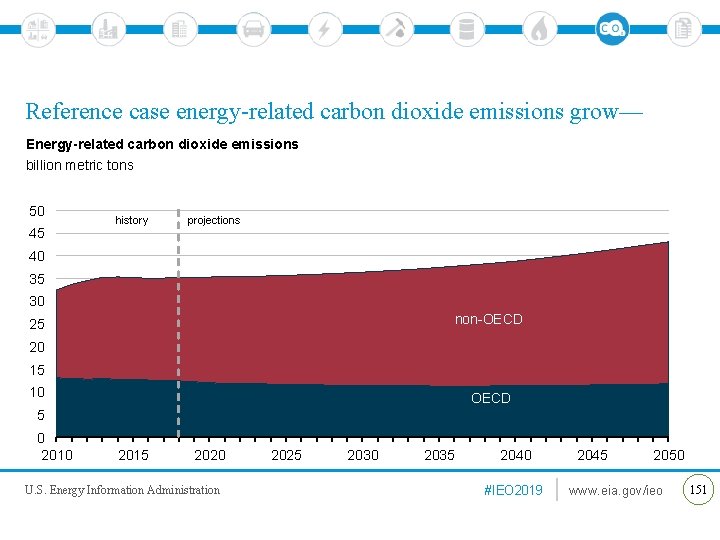
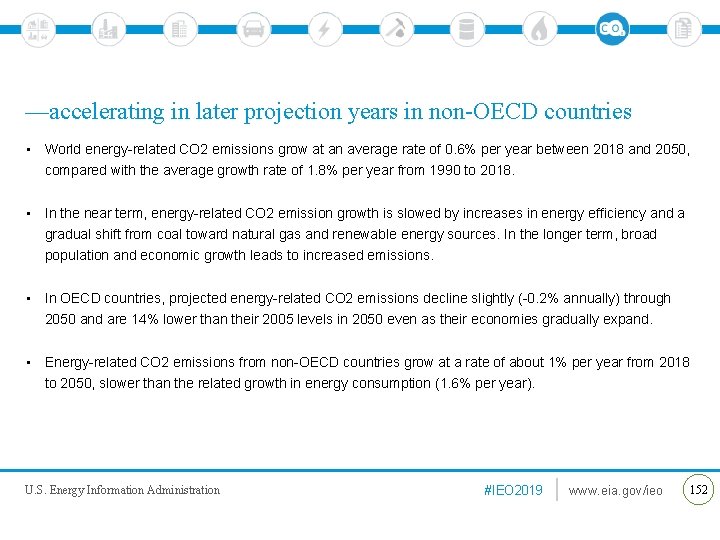
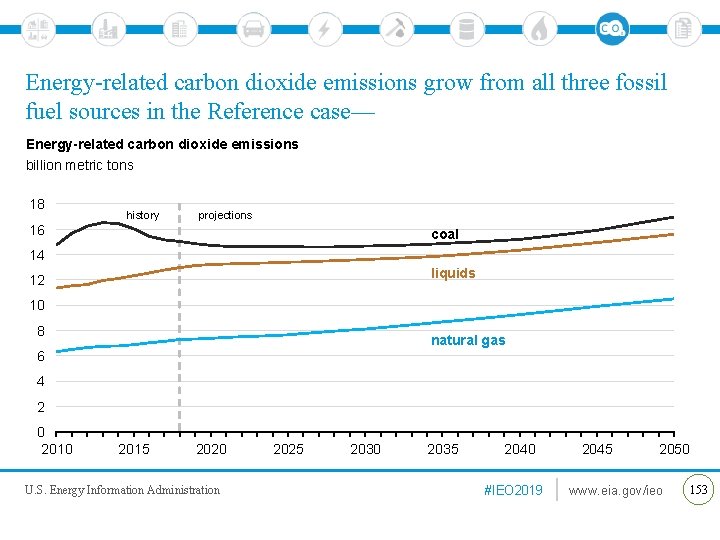
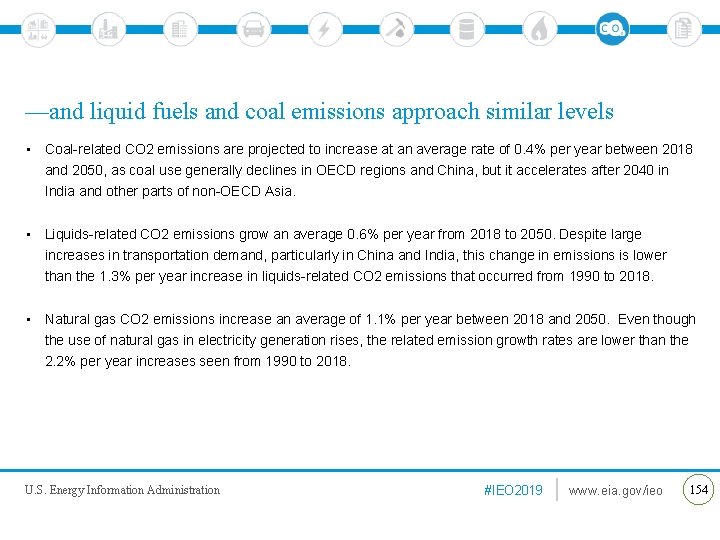
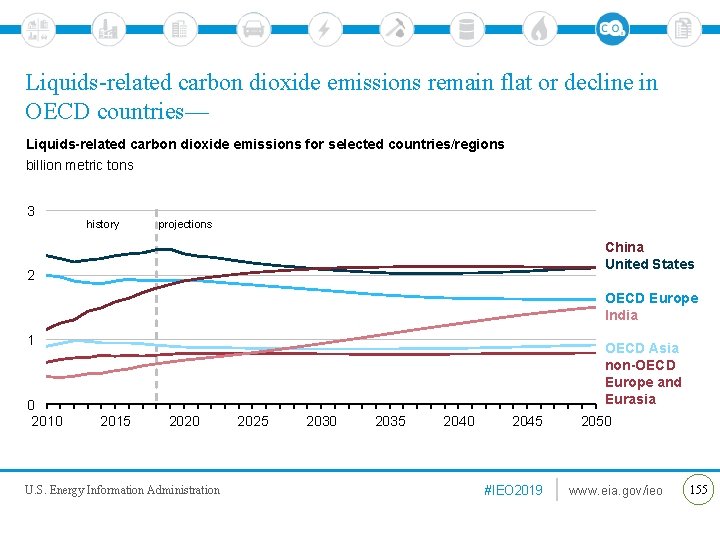
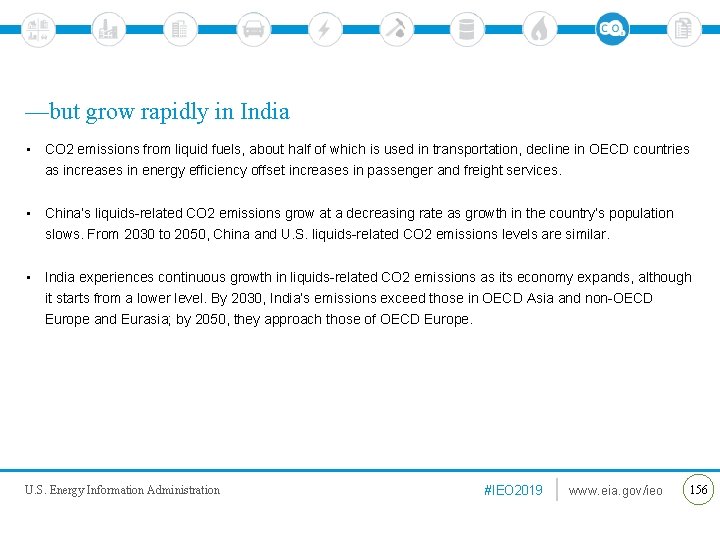
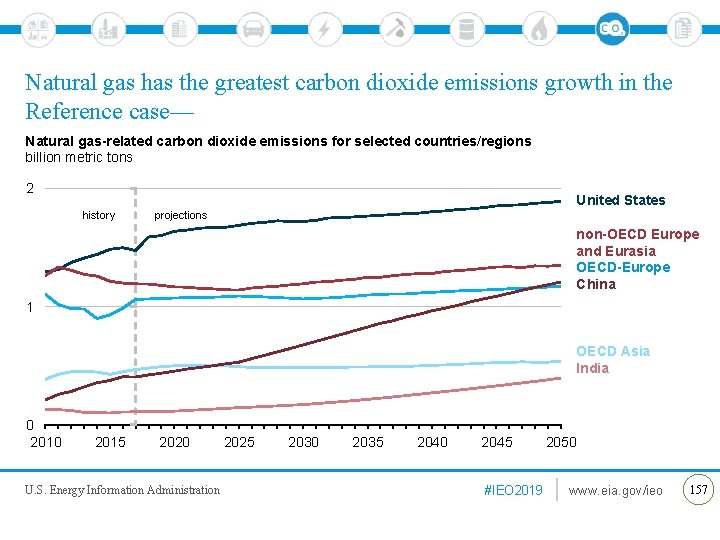
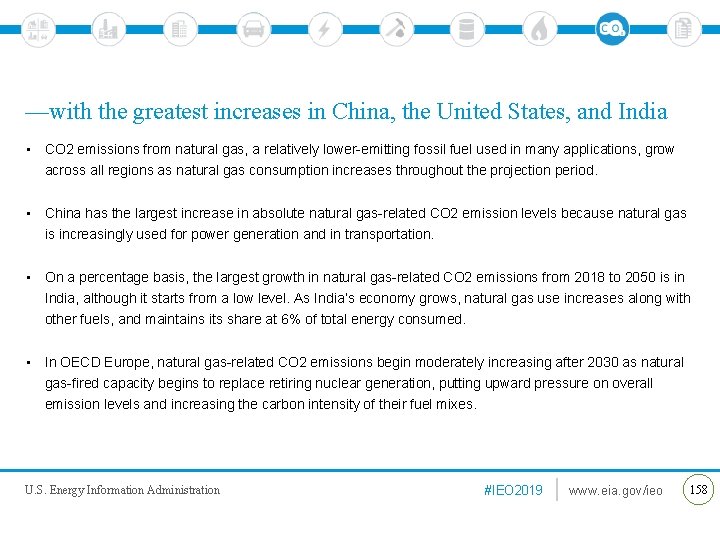
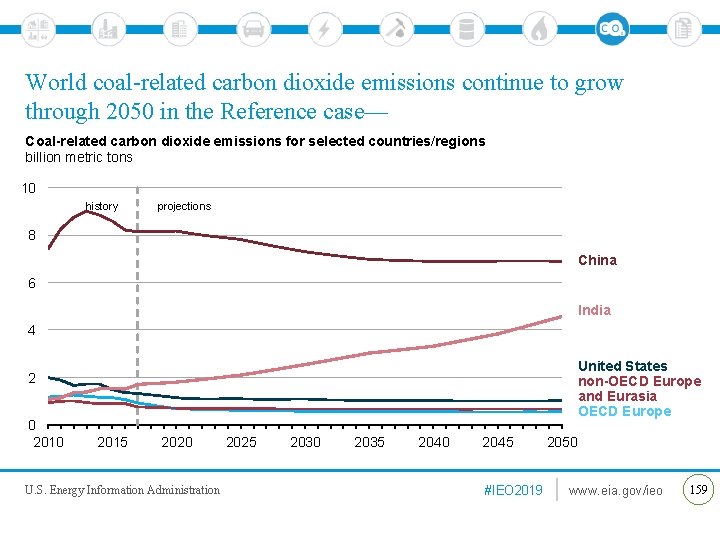
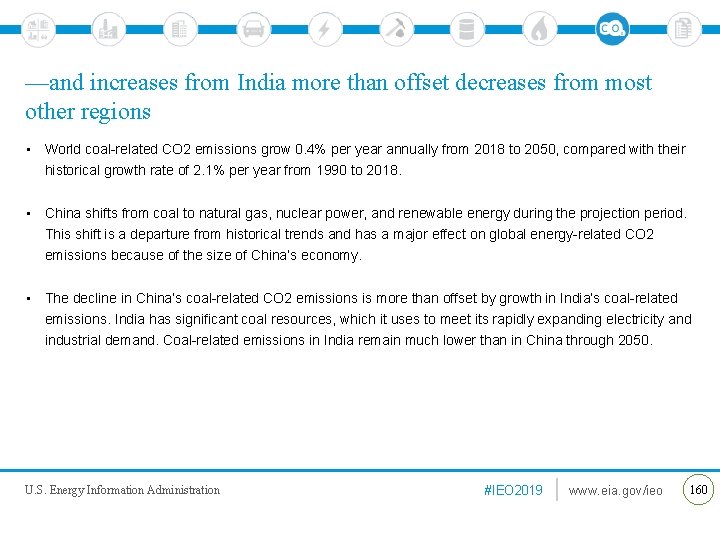


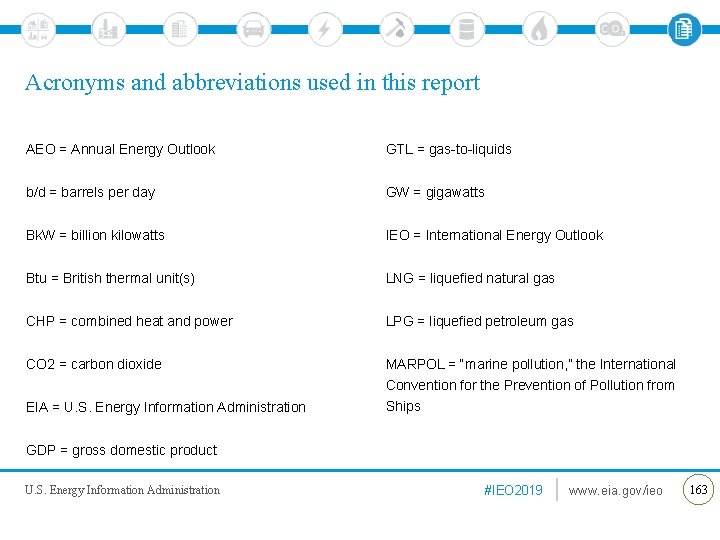
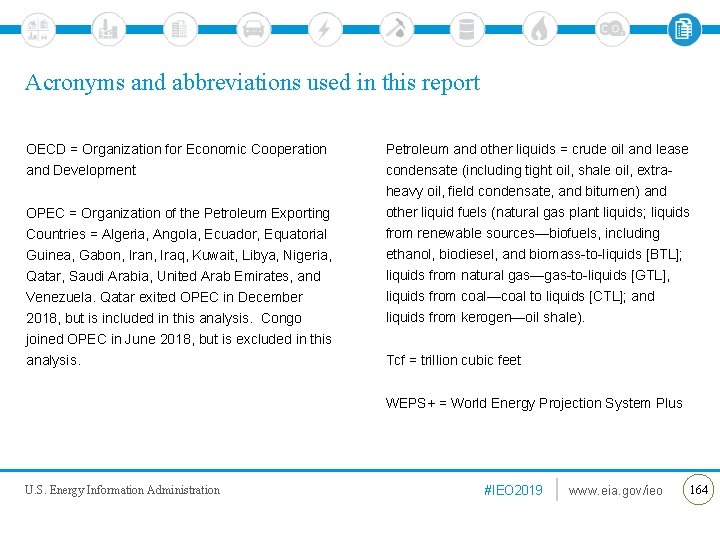
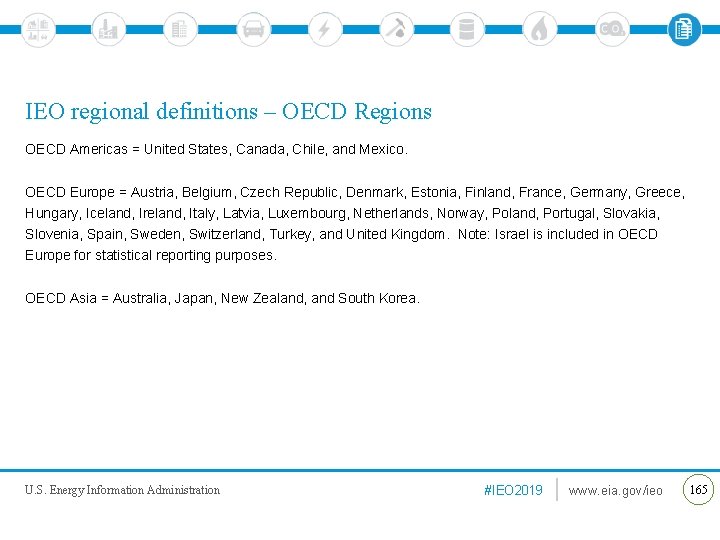
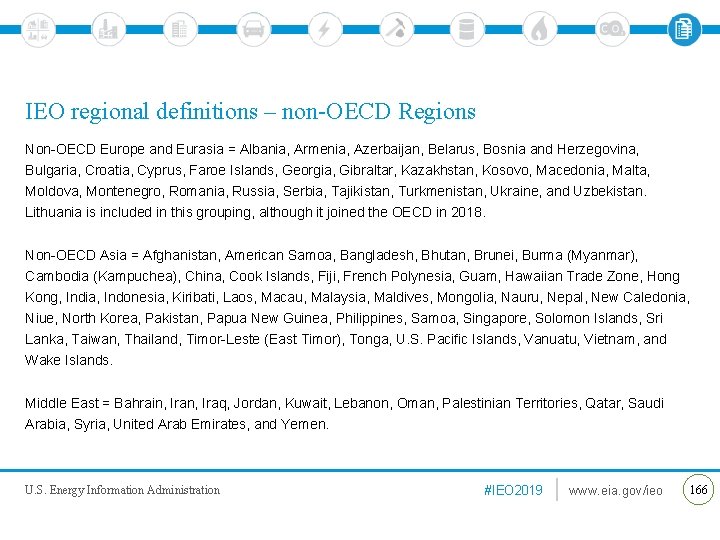
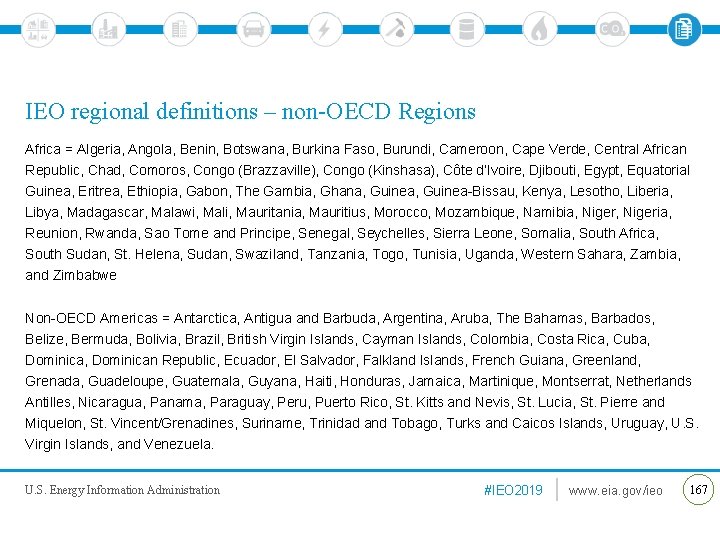
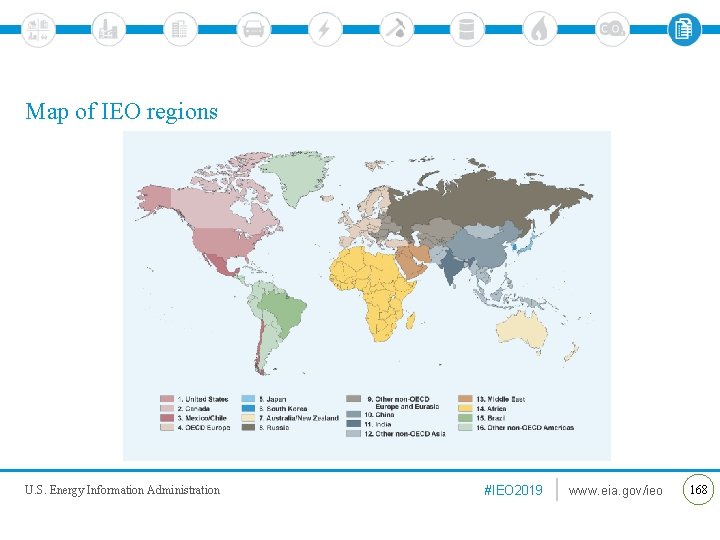
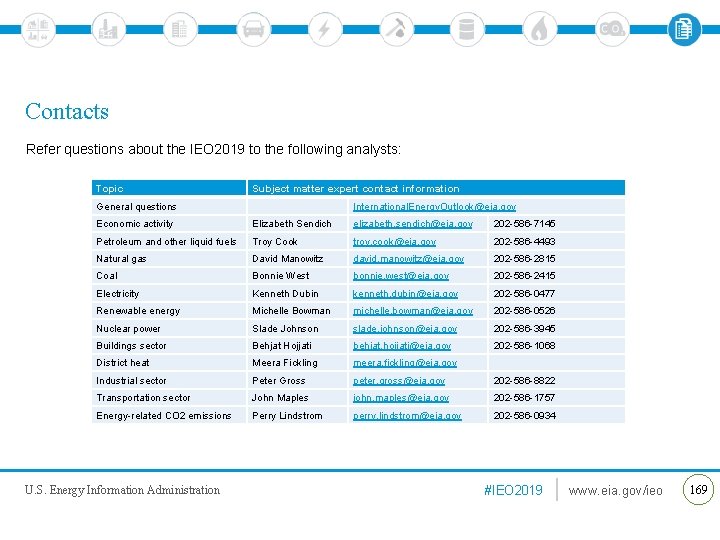
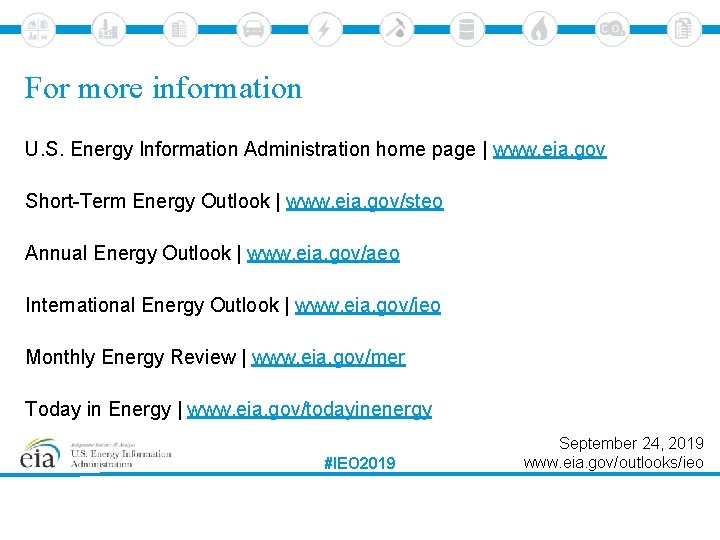
- Slides: 170

International Energy Outlook 2019 with projections to 2050 #IEO 2019 September 24, 2019 www. eia. gov/ieo

International Energy Outlook 2019 with projections to 2050 September 2019 U. S. Energy Information Administration Office of Energy Analysis U. S. Department of Energy Washington, DC 20585 This publication is on the Web at: https: //www. eia. gov/ieo This report was prepared by the U. S. Energy Information Administration (EIA), the statistical and analytical agency within the U. S. Department of Energy. By law, EIA's data, analyses, and forecasts are independent of approval by any other officer or employee of the United States Government. The views in this report therefore should not be construed as representing those of the Department of Energy or other federal agencies. U. S. Energy Information Administration #IEO 2019 www. eia. gov/ieo 2

International Energy Outlook 2019 is dedicated to the memory of Linda Doman. Linda led or contributed to the development of the International Energy Outlook for more than three decades. U. S. Energy Information Administration #IEO 2019 www. eia. gov/ieo 3

Table of contents Page Preamble 5 Consumption 16 Industrial 32 Buildings 48 Transportation 64 Electricity 84 Coal 104 Petroleum and other liquids 114 Natural gas 130 Energy-related carbon dioxide 146 References 160 U. S. Energy Information Administration #IEO 2019 www. eia. gov/ieo 4

Preamble U. S. Energy Information Administration #IEO 2019 www. eia. gov/ieo

U. S. Energy Information Administration #IEO 2019 www. eia. gov/ieo

The International Energy Outlook 2019 provides long-term world energy projections • The U. S. Energy Information Administration’s (EIA) International Energy Outlook (IEO) presents an analysis of long-term world energy markets in sixteen regions through 2050. • Reference case projections in each edition of the IEO are not predictions of what is most likely to happen, but rather they are modeled projections under various alternative assumptions. • The IEO projections are published under the Department of Energy Organization Act of 1977, which requires that EIA analyze “international aspects, economic and otherwise, of the evolving energy situation” and “long-term relationships between energy supply and consumption in the United States and world communities. ” • EIA develops the IEO using the World Energy Projection System Plus (WEPS+), an integrated economic model that captures long-term relationships among energy supply, demand, and prices across regional markets under various assumptions. • Energy market projections are uncertain because the events that shape future developments in technology, demographic changes, economic trends, and resource availability that drive energy use are fluid. U. S. Energy Information Administration #IEO 2019 www. eia. gov/ieo 7

The Reference case provides a baseline to measure the impact of alternative assumptions • The Reference case reflects current trends and relationships among supply, demand, and prices in the future. It is a reasonable baseline case to compare with cases that include alternative assumptions about economic drivers, policy changes, or other determinants of the energy system to estimate the potential impact of these assumptions. • The Reference case includes some anticipated changes over time: – Expected regional economic and demographic trends, based on the views of leading forecasters – Planned changes to infrastructure, both new construction and announced retirements – Assumed incremental cost and performance improvements in known technologies based on historical trends • This case does not include some of the potential future changes: – Changes to national boundaries and international agreements – Major disruptive geopolitical or economic events – Future technological breakthroughs – Changes to current policies as reflected in laws, regulations, and stated targets that indicate future activity U. S. Energy Information Administration #IEO 2019 www. eia. gov/ieo 8

Side cases address two significant sources of uncertainty • To see the impact of economic growth on energy consumption, EIA adjusted the assumptions about regional factors of growth in the High and Low Economic Growth cases. The resulting compound annual growth rates of global gross domestic product (GDP) during the projection period (2018– 2050) vary from the Reference case as follows: – 3. 7% per year, High Economic Growth case – 3. 0% per year, Reference case – 2. 4% per year, Low Economic Growth case • The High and Low Oil Price cases address the uncertainty associated with world energy prices. EIA altered the assumptions about both oil supply and demand to achieve higher and lower oil prices, as seen in the 2050 price of North Sea Brent crude oil in 2018 dollars: – $185/barrel, High Oil Price case – $100/barrel, Reference case – $45/barrel, Low Oil Price case U. S. Energy Information Administration #IEO 2019 www. eia. gov/ieo 9


Future oil prices are a key source of uncertainty in the projections— World oil prices in three cases real 2018 dollars per barrel World energy consumption in three cases quadrillion British thermal units 200 800 175 history projections 150 High Oil Price case 125 Reference case non-OECD 300 Low Oil Price case 50 High Oil Price Reference Low Oil Price 400 75 25 0 2010 600 500 100 High Oil Price Reference Low Oil Price 700 200 100 2020 2030 2040 U. S. Energy Information Administration 2050 0 2010 2020 2030 #IEO 2019 2040 2050 www. eia. gov/ieo 11

—with greater energy consumption differences in non-OECD regions • In addition to the Reference case, EIA includes a Low Oil Price case and a High Oil Price case that use different assumptions about future oil prices, based on different views of supply and demand for liquid fuels. • In the Low Oil Price case, lower economic activity, especially in countries that are not a part of the Organization of Economic Cooperation and Development (OECD), discourages energy consumption. Simultaneously but independently, greater resource availability and lower extraction costs encourage additional petroleum supplies, despite the reduced economic growth. The resulting lower oil prices encourage liquid fuels consumption and discourage energy conservation and fuel switching. • In the High Oil Price case, energy demand increases because non-OECD economies grow more quickly than in the Reference case, despite tighter petroleum supply conditions. Although energy consumption rises, higher oil prices limit the growth in liquid fuels, and consumers conserve or switch to alternative fuels whenever possible. U. S. Energy Information Administration #IEO 2019 www. eia. gov/ieo 12

EIA has identified an issue with the factors we used to convert data measured by energy content (British thermal units) to volumetric measurements (barrels) in the International Energy Outlook 2019 oil supply tables. As a result, we have removed the relevant tables and analysis, and we are investigating the issue. Once we resolve the issue and correct any errors, we will republish the updated content. Please contact the International Energy Outlook team (International. Energy. Outlook@eia. gov) with any questions. U. S. Energy Information Administration #IEO 2019 www. eia. gov/ieo 13

EIA has identified an issue with the factors we used to convert data measured by energy content (British thermal units) to volumetric measurements (barrels) in the International Energy Outlook 2019 oil supply tables. As a result, we have removed the relevant tables and analysis, and we are investigating the issue. Once we resolve the issue and correct any errors, we will republish the updated content. Please contact the International Energy Outlook team (International. Energy. Outlook@eia. gov) with any questions. U. S. Energy Information Administration #IEO 2019 www. eia. gov/ieo 14

Energy consumption varies considerably across the High and Low Economic Growth cases— Energy consumption quadrillion British thermal units Gross domestic product trillion 2010 dollars 300 history High Economic Growth projections 250 Reference Low Economic Growth 200 150 non-OECD High Economic Growth Reference Low Economic Growth 100 50 0 2010 OECD 2020 2030 2040 2050 U. S. Energy Information Administration 800 High Economic Growth Reference Low Economic Growth 700 600 500 non-OECD High Economic Growth Reference Low Economic Growth 400 300 OECD 200 100 0 2010 2020 2030 #IEO 2019 2040 2050 www. eia. gov/ieo 15

—with greater variation across non-OECD regions • From 2018 to 2050, world real GDP increases by 3. 0% per year in the Reference case, 3. 7% in the High Economic Growth case, and 2. 4% per year in the Low Economic growth case. • In OECD countries, over the same time period, real GDP increases by 1. 5% per year in the Reference case, 2. 1% per year in the High Economic Growth case, and 1. 1% per year in the Low Economic growth case. • In non-OECD countries, during the same time period, growth is 3. 8% per year in the Reference case, 4. 6% in the High Economic Growth case, and 3. 2% in the Low Economic Growth case. • In the Reference case, world energy consumption totals 911 quadrillion British thermal units (Btu) in 2050 — 287 quadrillion Btu in the OECD countries and 624 quadrillion Btu in the non-OECD countries. In the High Economic Growth case, world energy use in 2050 is about 1, 090 quadrillion Btu. In the Low Economic Growth case, world energy use in 2050 is about 830 quadrillion Btu. U. S. Energy Information Administration #IEO 2019 www. eia. gov/ieo 16

Consumption U. S. Energy Information Administration #IEO 2019 www. eia. gov/ieo

U. S. Energy Information Administration #IEO 2019 www. eia. gov/ieo

Economic growth is highest in non-OECD countries in the Reference case – World gross domestic product (GDP) trillion 2010 dollars, purchasing power parity (PPP) 250 history projections World per capita GDP thousand 2010 dollars PPP 70 60 200 50 150 non-OECD 100 OECD 40 30 OECD 50 20 non-OECD 10 0 2010 2020 2030 2040 U. S. Energy Information Administration 2050 0 2010 2030 #IEO 2019 2050 www. eia. gov/ieo 19

—where per capita GDP grows rapidly as a result of economic development • In the Reference case, combined gross domestic product (GDP) in the countries that are not part of the Organization of Economic Cooperation and Development (OECD) grows by 3. 8% per year on average between 2018 and 2050, compared with 1. 5% per year in the OECD countries. • Since 1990, non-OECD countries have led world economic growth, accompanied by strong growth in energy demand in those countries. • GDP person, an indicator of a country's standard of living, increases similarly in OECD and non. OECD regions in absolute terms. However, the proportional increase in non-OECD countries is much larger, more than double (a 150% increase) between 2018 and 2050, as opposed to less than a 50% increase in OECD countries. U. S. Energy Information Administration #IEO 2019 www. eia. gov/ieo 20

Economic growth varies widely across non-OECD regions in the Reference case— Average annual percent change in GDP, 2018 -2050 percent per year OECD non-OECD Australia and New Zealand India Africa other Asia China Middle East other Americas other Europe and Eurasia Brazil Russia Mexico and Chile United States South Korea Canada OECD Europe Japan total OECD -4 total non-OECD 1 U. S. Energy Information Administration 6 0 #IEO 2019 1 2 3 4 5 www. eia. gov/ieo 6 21

—with the highest rates occurring in non-OECD Asia and Africa • Both OECD and non-OECD regions are diverse, with wide spreads in economic growth. • In the non-OECD regions, India, China, other Asia, and Africa grow at an average rate of nearly 4% or higher. These regions were home to about two-thirds of the world’s population in 2018. • Japan (OECD) and Russia (non-OECD) are the slowest-growing economies, partly as a result of declining populations and aging workforces. • The projected GDP growth in China slows considerably compared with its growth from 2000 to 2010, when GDP increased by an average of about 10% per year. U. S. Energy Information Administration #IEO 2019 www. eia. gov/ieo 22

World energy consumption rises nearly 50% between 2018 and 2050 in the Reference case — World energy consumption quadrillion British thermal units 1, 000 history projections non-OECD 800 600 400 OECD 200 0 2010 2020 U. S. Energy Information Administration 2030 2040 2050 #IEO 2019 www. eia. gov/ieo 23

—with almost all of the increase occurring in non-OECD countries • In the Reference case, most increases in energy consumption come from non-OECD countries, where strong economic growth, increased access to marketed energy, and rapid population growth lead to rising energy consumption. • In OECD countries, growth in energy consumption is slower as a result of relatively slower population and economic growth, improvements in energy efficiency, and less growth in energy-intensive industries. • Energy consumption in non-OECD countries increases nearly 70% between 2018 and 2050 in contrast to a 15% increase in OECD countries. U. S. Energy Information Administration #IEO 2019 www. eia. gov/ieo 24

In the Reference case, non-OECD Asia accounts for most of the increase in energy use— Non-OECD energy consumption by region quadrillion British thermal units 700 history projections Asia 600 500 400 300 200 Middle East Africa Americas Europe and Eurasia 100 0 2010 2020 U. S. Energy Information Administration 2030 2040 2050 #IEO 2019 www. eia. gov/ieo 25

—but substantial growth also occurs in other non-OECD regions • More than half of the projected increase in global energy consumption occurs in non-OECD Asian countries, a group that includes China and India. Energy demand in non-OECD Asia is larger than in any other region in 2018, and it is projected to almost double between 2018 and 2050, making it both the largest and fastest-growing region in the world for energy consumption. • China and India have been among the world’s fastest-growing economies during much of the past decade, and they remain primary contributors to future growth in world energy demand. • Non-OECD regions outside of Asia contribute to substantial increases in energy consumption. Fastpaced population growth and access to ample domestic resources are important determinants of energy demand in Africa and the Middle East, where energy use increases about 110% and 55%, respectively, between 2018 and 2050. • Non-OECD Europe and Eurasia has the smallest projected increase in energy consumption (11%). Much of the low growth is related to Russia, where the population declines. The low growth is also a result of significant gains in energy efficiency achieved by replacing older physical assets with more efficient ones. U. S. Energy Information Administration #IEO 2019 www. eia. gov/ieo 26

The industrial sector is the largest consumer of energy— Energy consumption by sector quadrillion British thermal units OECD 450 history 450 projections non-OECD 400 residential 350 commercial transportation 300 250 200 residential commercial 150 transportation 100 150 100 industrial 50 0 2010 industrial 200 2020 2030 2040 2050 U. S. Energy Information Administration 50 0 2010 2020 2030 #IEO 2019 2040 2050 www. eia. gov/ieo 27

—and constitutes more than half of global energy consumption • The industrial sector, which includes refining, manufacturing, agriculture, and construction, accounts for the largest share of energy consumption of any end-use sector—more than 50% of end-use energy consumption during the entire projection period. World industrial sector energy use increases by more than 30% from 2018 to 2050, reaching about 315 quadrillion British thermal units (Btu) by 2050. • Gross output, a measure of total sales across sectors, more than doubles during the projection period from 2018 to 2050, and about half of this growth is related to industrial activity. The remaining growth comes from the service sector and reflects non-industrial activities. • Most of the increase in industrial sector energy use occurs in non-OECD nations. Industrial sector energy use in non-OECD countries grows by more than 1. 0% per year in the Reference case compared with an increase of 0. 5% per year in OECD countries. U. S. Energy Information Administration #IEO 2019 www. eia. gov/ieo 28

While energy consumption in each end-use sector grows— End-use energy consumption by sector, world quadrillion British thermal units End-use energy consumption by fuel, world quadrillion British thermal units 350 300 industrial history projections 300 250 200 150 transportation residential 100 50 commercial 50 U. S. Energy Information Administration electricity natural gas coal 150 100 0 2010 2020 2030 2040 2050 petroleum and other liquids 0 2010 renewables 2020 2030 #IEO 2019 2040 2050 www. eia. gov/ieo 29

—end-use fuel composition increasingly shifts toward electricity • End-use fuels include those fuels consumed in the industrial, transportation, and buildings sectors and exclude fuels used for electric power generation. • Liquid fuels, because of energy density, cost, and chemical properties, continue to be the predominant transportation fuel and an important industrial feedstock. • Electricity use in the residential and commercial building sectors increases rapidly because of growing income, a growing population, and increased access to electricity in non-OECD regions. • Electricity use in the industrial sector and transportation sector also grows, respectively, as a result of increasing product demand increasing use of electric vehicles. • Coal continues to be an important end-use fuel in industrial processes, including the production of cement and steel. U. S. Energy Information Administration #IEO 2019 www. eia. gov/ieo 30

Renewable energy becomes the leading source of primary energy consumption by 2050 in the Reference case— Primary energy consumption by energy source, world quadrillion British thermal units share 300 100% history projections 250 200 150 renewables petroleum and other liquids natural gas coal renewables 90% 80% petroleum and other liquids 70% 60% 50% coal 40% 100 50 30% natural gas 20% nuclear 0 2010 2020 2030 2040 2050 U. S. Energy Information Administration 10% nuclear 0% 2018 #IEO 2019 2050 www. eia. gov/ieo 31

—although consumption increases for all primary energy sources • Use of all primary energy sources grows throughout the Reference case. Although renewable energy is the world’s fastest growing form of energy, fossil fuels to continue to meet much of the world’s energy demand. • Driven by electricity demand growth and economic and policy drivers, worldwide renewable energy consumption increases by 3% per year between 2018 and 2050. Nuclear consumption increases by 1% per year. • As a share of primary energy consumption, petroleum and other liquids declines from 32% in 2018 to 27% in 2050. On an absolute basis, liquids consumption increases in the industrial, commercial, and transportation sectors and declines in the residential and electric power sectors. • Natural gas is the world’s fastest growing fossil fuel, increasing by 1. 1% per year, compared with liquids’ 0. 6% per year growth and coal’s 0. 4% per year growth. • Coal use is projected to decline until the 2030 s as regions replace coal with natural gas and renewables in electricity generation as a result of both cost and policy drivers. In the 2040 s, coal use increases as a result of increased industrial usage and rising use in electric power generation in non-OECD Asia excluding China. U. S. Energy Information Administration #IEO 2019 www. eia. gov/ieo 32

Industrial U. S. Energy Information Administration #IEO 2019 www. eia. gov/ieo

U. S. Energy Information Administration #IEO 2019 www. eia. gov/ieo

World industrial gross output growth continues to slow— Industrial gross output growth year-over-year percent Industrial energy consumption quadrillion British thermal units 14% 350 history projections 12% 300 10% 250 8% non-OECD 200 6% 4% 2% non-OECD 150 OECD 100 OECD 50 0% 0 -2% 2010 2020 2030 2040 U. S. Energy Information Administration 2050 2010 2020 2030 2040 2050 #IEO 2019 www. eia. gov/ieo 35

—but non-OECD industrial energy consumption growth remains strong in the Reference case • Growth in industrial gross output, a measure of sales across industrial sectors, slows worldwide in the Reference case from 4. 2% in 2018 to 2. 2% in 2050. Industrial gross output growth in countries that are not part of the Organization of Economic Cooperation and Development (OECD) slows from 5. 0% in 2018 to 2. 3% in 2050, but it continues to outpace growth in OECD countries, which slows from 2. 2% in 2018 to 1. 3% in 2050. • Industrial consumption of delivered energy grows slowly from 2018 to 2050 at less than 0. 5% per year in OECD countries and at 1. 1% per year in non-OECD countries. • Industrial output growth outpaces energy consumption because of increased industrial energy efficiency and higher growth in non-energy-intensive manufacturing output in key regions, especially in non-OECD countries. • Declining industrial energy consumption in China is more than offset by growth in other non-OECD countries. • The industrial share of worldwide energy consumption declines from about 40% in 2018 to 35% in 2050, largely because of faster growth in the transportation sector. U. S. Energy Information Administration #IEO 2019 www. eia. gov/ieo 36

In the Reference case, gross output from industrial activities doubles by 2050— Gross output by sector, world trillion 2010 dollars PPP Energy consumption by industrial subsector, world quadrillion British thermal units 700 350 600 500 history projections services (non-industrial sector) 400 300 200 100 energy intensive manufacturing 300 250 200 energy-intensive manufacturing non-energyintensive manufacturing non-manufacturing 0 2010 2020 2030 2040 2050 U. S. Energy Information Administration non-energyintensive manufacturing 150 100 50 nonmanufacturing 0 2010 2020 2030 2040 2050 #IEO 2019 www. eia. gov/ieo 37

—with about half of industrial energy consumption in the energyintensive industries • World gross output, a measure of total sales across business sectors, more than doubles worldwide from 2018 to 2050, with about half of this growth related to industrial activity. The remaining growth comes from the services sector and reflects non-industrial activities (i. e. , commercial sector energy consumption). • Gross output shares remain steady across industrial subsectors, with energy-intensive manufacturing (basic chemicals, food, iron and steel, non-ferrous metals, non-metallic minerals, paper, and refining) maintaining about a 28% share throughout the projection period. Non-energy-intensive manufacturing (metal-based durables, other chemicals, and other manufacturing) grows from 43% to 45%, and nonmanufacturing sectors decline from 29% to 27%. • Following these gross output trends, the share of energy consumed by energy-intensive manufacturing holds steady at about 50% from 2018 to 2050. During the same period, the share of energy consumed by non-energy-intensive manufacturing increases from 35% to 38%. U. S. Energy Information Administration #IEO 2019 www. eia. gov/ieo 38

Energy-intensive manufacturing continues its shift toward non. OECD Asia— Energy-intensive manufacturing gross output by region share history projections 100% rest of world 90% 80% 70% India 60% 50% China 40% 30% 20% other non-OECD Asia Africa 10% 0% 2010 2020 U. S. Energy Information Administration 2030 2040 2050 #IEO 2019 www. eia. gov/ieo 39

—with India’s share growing steadily during the projection period • Gross output for energy-intensive manufacturing, which includes the production of iron and steel, food, paper, refined oil products, non-metallic minerals, aluminum, and basic chemicals, is increasingly concentrated in the non-OECD countries of Asia. India and China combined account for more than half of global output throughout the Reference case. • India and China see growth in energy-intensive manufacturing during the projection period, but India’s share of the global activity increases, from 11% in 2018 to 25% in 2050, while China’s share decreases, from 41% to 35%. • Other regions gaining share of energy-intensive manufacturing include other non-OECD Asia and Africa, while the rest of the world, collectively, decreases its share of energy-intensive manufacturing. U. S. Energy Information Administration #IEO 2019 www. eia. gov/ieo 40

Non-OECD Asia leads industrial energy consumption growth— Industrial energy consumption quadrillion British thermal units 250 OECD history non-OECD 250 projections China 200 150 100 Asia Americas 50 India 100 other Asia Middle East Africa Americas Europe and Eurasia 50 Europe 0 2010 2020 2030 2040 2050 U. S. Energy Information Administration 0 2010 2020 2030 2040 #IEO 2019 2050 www. eia. gov/ieo 41

—but China remains the world’s largest single industrial energy consumer and India experiences the most growth in consumption • Non-OECD countries collectively consume more energy in the industrial sector than OECD countries, and their energy consumption growth is about twice the rate as in OECD countries through the projection period. • In 2018, China consumed 29% of the world’s industrial energy, and although its energy consumption continues to increase modestly throughout the projection period, its share decreases to 24% by 2050. • India’s industrial energy consumption nearly triples, growing from 16 quadrillion British thermal units (Btu) in 2018 to 47 quadrillion Btu by 2050 at an average annual rate of 3. 4%. • India’s 31 quadrillion Btu growth in energy consumption from 2018 to 2050 represents 40% of the total world increase of 78 quadrillion Btu. U. S. Energy Information Administration #IEO 2019 www. eia. gov/ieo 42

Non-OECD countries lead industrial energy consumption growth — Industrial sector energy consumption by fuel quadrillion British thermal units 250 OECD history non-OECD 250 projections renewables 200 natural gas 150 electricity 100 50 50 0 2010 2020 2030 2040 U. S. Energy Information Administration 2050 0 2010 liquids coal 2020 2030 #IEO 2019 2040 2050 www. eia. gov/ieo 43

—and coal remains the most-used industrial fuel but renewables have the fastest rate of growth • Although coal consumption in non-OECD countries dips slightly through 2035 and then rebounds and grows through 2050, coal remains the most common industrial energy source in these regions. By 2050, industrial coal use declines to about one-quarter of all industrial energy consumption. • Among industrial fuels, renewables have the highest growth rate among non-OECD countries at 1. 7% per year, but they represent only 10% of industrial energy consumption by 2050. U. S. Energy Information Administration #IEO 2019 www. eia. gov/ieo 44

Led by India, industrial use of coal in non-OECD Asia increases after the mid-2020 s— Industrial consumption quadrillion British thermal units Industrial energy consumption, India quadrillion British thermal units 90 90 80 history projections 80 70 rest of world 60 India 60 50 50 40 China 30 coal petroleum and other liquids natural gas renewables electricity 40 30 20 other non-OECD Asia 10 0 2010 70 2020 2030 2040 2050 U. S. Energy Information Administration 20 10 0 2010 2020 2030 2040 #IEO 2019 2050 www. eia. gov/ieo 45

—as a result of growth in coal-intensive industries and relatively low coal prices • In 2018, China accounted for more than 60% of the world’s industrial consumption, but its share falls to a little more than 40% in 2050 because of consumption growth in other countries and China’s policies to reduce coal use in the industrial sector. However, in the Reference case, China remains the world’s largest industrial consumer because of continued coal use in the chemicals sector. • Growth in India’s steel and cement sectors makes India the country with the highest industrial coal growth rate in the world. By 2050, more than two-thirds of worldwide industrial coal is consumed in India and China. • In the Reference case, flat coal prices relative to increasing natural gas prices keep coal a preferred industrial fuel for boilers and process heat. • In the Reference case, natural gas prices in China are nearly double coal prices on an energy equivalent basis by 2050, which leads to an increase in coal consumption in the later years. • Natural gas prices in India are consistently higher than coal and reach almost four times that of coal on an energy equivalent basis by 2050, encouraging industrial coal use instead of natural gas. U. S. Energy Information Administration #IEO 2019 www. eia. gov/ieo 46

Non-OECD economies increase industrial electricity use— Energy consumption, non-OECD motor vehicle production quadrillion British thermal units 6 history Energy consumption, non-OECD non-ferrous metals production quadrillion British thermal units 6 projections electricity 5 5 4 4 3 3 2 2 1 1 0 2010 2020 2030 2040 U. S. Energy Information Administration 2050 coal natural gas liquids 2020 2030 2040 #IEO 2019 2050 www. eia. gov/ieo 47

—led by growth in the motor vehicle and non-ferrous metals industries • Non-OECD countries increase industrial electricity consumption by 49% from 2018 to 2050 while OECD nations experience an increase of 19% during the same period. • Emerging economies with industrial sectors that are not fully developed have a greater ability to increase electrification as newer technologies are used. From 2018 to 2050, purchased electricity is the fastestgrowing fuel consumed in the non-OECD industrial sector; natural gas is the fastest-growing fuel in the OECD. • Industrial energy shares change slowly. Non-OECD industrial sector electricity consumption as a share of total energy consumption grows from 16% to 17% from 2018 to 2050, while it remains at about 15% in the OECD countries. • The metal-based durables and non-ferrous metals industries experience significantly greater growth in their share of electricity consumption. • Electricity as a share of motor vehicle manufacturing energy consumption increases from 56% in 2018 to 62% in 2050 in non-OECD countries, while OECD consumption in this industry remains steady at 55% during the same period. Declining electricity prices in non-OECD regions contribute to this change. U. S. Energy Information Administration #IEO 2019 www. eia. gov/ieo 48

Buildings U. S. Energy Information Administration #IEO 2019 www. eia. gov/ieo

U. S. Energy Information Administration #IEO 2019 www. eia. gov/ieo

Non-OECD countries drive increases in building energy consumption — Building sector energy consumption quadrillion British thermal units non-OECD 100 history 100 projections 80 80 60 60 40 40 20 2010 2020 2030 2040 2050 U. S. Energy Information Administration 0 2010 residential commercial 2020 2030 2040 #IEO 2019 2050 www. eia. gov/ieo 51

—as population and incomes grow faster in non-OECD countries • Energy consumed in the buildings sector, which includes residential and commercial structures, increases by 1. 3% per year in the Reference case—a growth rate greater than that of worldwide annual population—up from 91 quadrillion to 139 quadrillion British thermal units (Btu) from 2018 to 2050. The buildings sector’s share of the world’s delivered energy consumption increases from about 20% in 2018 to 22% in 2050. • Most of the increase in energy use comes from countries that are not part of the Organization of Economic Cooperation and Development (OECD). Non-OECD countries are experiencing rising income, urbanization, and increased access to electricity, which lead to rising demand for energy. Building energy consumption in non-OECD countries increases at about 2% per year, about five times faster than in OECD countries, and non-OECD building energy consumption surpasses that of OECD countries by 2025. • In OECD countries, buildings energy consumption is projected increases at an average of 0. 4% per year from 2018 to 2050, reflecting slow growth in personal income and gains in energy efficiency as a result of improved building shells, appliances, and equipment. U. S. Energy Information Administration #IEO 2019 www. eia. gov/ieo 52

Residential energy consumption person increases in non-OECD countries— Residential energy consumption person million British thermal units person non-OECD Russia Canada Middle East United States China 2018 2050 OECD Europe 2018 2050 other Europe and Eurasia India Australia and New Zealand other Americas South Korea Brazil Japan other Asia Mexico and Chile Africa 0 10 20 30 40 U. S. Energy Information Administration 0 10 #IEO 2019 20 30 40 www. eia. gov/ieo 53

—but remains lower on average than residential person energy consumption in OECD countries • In the Reference case, world residential energy consumption person (energy intensity) increases by 0. 6% per year from 2018 to 2050, as residential energy consumption (1. 4% per year) grows faster than world population growth (0. 7% per year). EIA does not consider non-marketed sources of energy, such as wood and waste in its IEO analyses. • In OECD countries, residential energy intensity decreases by an average of 0. 1% per year from 2018 to 2050, compared with an average increase of 1. 3% per year in non-OECD countries during the same period. • In the Reference case, India experiences the fastest relative growth in person residential energy use because of increased access to energy sources and increased use of appliances and other energy-using equipment. However, in 2050, India’s residential use person is only about 24% of that in the United States. • Although residential energy intensity in Africa grows by about 16% from 2018 to 2050, it remains the least energy-intensive region. U. S. Energy Information Administration #IEO 2019 www. eia. gov/ieo 54

Non-OECD countries, led by growing demand in China and India— OECD residential energy consumption quadrillion British thermal units Non-OECD residential energy consumption quadrillion British thermal units 70 history 70 projections 60 60 50 50 40 40 30 Asia Americas 20 India 30 other Asia Middle East Africa Americas Europe and Eurasia 20 Europe 10 0 China 2010 2020 2030 2040 2050 U. S. Energy Information Administration 10 0 2010 2020 2030 #IEO 2019 2040 2050 www. eia. gov/ieo 55

—account for most of the increase in residential energy consumption • OECD countries have modest growth in residential energy consumption, growing only 7% from 2018 to 2050. • Non-OECD Asia, a region that includes India and China, remains the fastest-growing region in residential sector energy consumption. About 70% of the projected increase in residential energy consumption occurs in non-OECD Asia, as standards of living increase and as demand for lighting and energy-using appliances and equipment increases. • China adds the most residential energy consumption of any country (in absolute terms), while India experiences the fastest relative growth in residential energy consumption from 2018 to 2050. • Residential energy consumption in Africa grows by an average of 2. 5% per year from 2018 to 2050— which is faster than its population growth of 1. 9% per year. U. S. Energy Information Administration #IEO 2019 www. eia. gov/ieo 56

In the Reference case, residential energy consumption increases from 2018 to 2050— Residential sector energy consumption by fuel quadrillion British thermal units non-OECD 70 70 history projections 60 60 50 50 40 40 30 30 20 20 10 10 0 2010 2020 2030 2040 U. S. Energy Information Administration 2050 0 2010 electricity natural gas liquids renewables coal 2020 2030 #IEO 2019 2040 2050 www. eia. gov/ieo 57

—led by electricity and natural gas consumption growth • Electricity remains the main source of marketed energy consumption in the residential sector, and its use grows by 2. 5% per year globally as rising population and standards of living in non-OECD countries increase the demand for appliances and personal equipment. • Residential natural gas consumption increases by 0. 7% per year during the projection period, influenced by increasing use of natural gas for heating. • Coal consumption, used primarily for space heating, water heating, and cooking, continues to decline in the residential sector. U. S. Energy Information Administration #IEO 2019 www. eia. gov/ieo 58

In the Reference case, non-OECD countries account for much of the increase in commercial sector energy consumption— OECD commercial energy consumption quadrillion British thermal units Non-OECD commercial energy consumption quadrillion British thermal units 30 30 history projections 25 Asia 20 25 China 20 Americas 15 15 10 10 Europe 5 5 0 0 2010 2020 2030 2040 2050 U. S. Energy Information Administration India other Asia Middle East Africa Americas Europe and Eurasia 2010 2020 2030 2040 2050 #IEO 2019 www. eia. gov/ieo 59

—led by increasing demand in non-OECD Asia • The need for commercial services increases as populations and economies grow, which affects energy consumption for appliances, lighting, and other equipment in buildings. Non-OECD commercial sector energy consumption remains lower than in the OECD throughout the projection period, but it increases at about three times the rate of OECD commercial energy consumption. • Non-OECD Asia (China, India, and other non-OECD Asian countries) remains the fastest-growing region in the commercial sector. About 66% of the projected increase in non-OECD commercial energy consumption occurs in non-OECD Asia. • Commercial energy consumption increases the most in China (in absolute terms), although India experiences the fastest relative growth in commercial energy consumption from 2018 to 2050. • Africa has the second-highest projected rate of commercial energy consumption growth among the non. OECD regions, averaging 2. 4% per year through the projection period. U. S. Energy Information Administration #IEO 2019 www. eia. gov/ieo 60

World commercial energy consumption continues to increase— Commercial sector energy consumption by fuel quadrillion British thermal units non-OECD 30 30 history projections 25 25 20 20 15 15 10 10 5 5 0 2010 2020 2030 2040 U. S. Energy Information Administration 2050 electricity natural gas liquids coal renewables 2020 2030 #IEO 2019 2040 2050 www. eia. gov/ieo 61

—led by a faster growth rate in non-OECD electricity use • From 2018 to 2050, OECD countries use more energy in the commercial sector than in non-OECD countries. • Electricity and natural gas remain the most prominent energy sources in the commercial sector. • Electricity is the fastest-growing source of energy use in the commercial sector. Commercial electricity use in non-OECD countries increases by an average of 2. 8% per year from 2018 to 2050, compared with 1. 1% per year in OECD countries. • Commercial natural gas consumption in non-OECD countries grows by 1. 4% per year from 2018 to 2050, which is about four times the rate of the increase in OECD commercial sector. U. S. Energy Information Administration #IEO 2019 www. eia. gov/ieo 62

China switches from district heat to combined heat and power (CHP) for heating— Heat generation by source in China quadrillion British thermal units 6 combined heat and power 5 Coal consumption by buildings in China quadrillion British thermal units 6 5 4 4 3 3 other uses 2 U. S. Energy Information Administration #IEO 2019 2050 2046 2042 2038 2034 district heat 2030 0 2026 2050 2046 2042 2038 2034 2030 2026 2022 2018 0 1 2022 district heat (heat only boilers) 1 2018 2 www. eia. gov/ieo 63

—which results in a significant decline in coal consumption in its buildings • Coal is the main fuel for heating in China’s building sector in 2018; however, policies encourage a switch to clean heating sources. About two-thirds of northern China’s floorspace relies on district heat for space heating. Recent policies target a transition away from small-scale, coal-fired boilers for heating in this region, contributing to a larger trend of declining coal consumption in China. • China’s 2017– 21 clean winter heating plan calls for 70% of northern China’s needs to be met through natural gas, electricity, renewables, CHP, or more efficient coal boilers. • Along with electricity-sector growth and fuel price shifts, this policy drives a transition from coal-fired heatonly boilers to CHP. The remaining district heat boilers are more efficient, and natural gas assumes a larger share of heat generation. • Although district heat accounts for only 17% of building sector coal consumption in 2018, it accounts for more than 50% of the overall decline in buildings’ coal consumption from 2018 to 2050. U. S. Energy Information Administration #IEO 2019 www. eia. gov/ieo 64

Transportation U. S. Energy Information Administration #IEO 2019 www. eia. gov/ieo

U. S. Energy Information Administration #IEO 2019 www. eia. gov/ieo

Transportation energy consumption continues to grow in non-OECD countries— Transportation energy consumption quadrillion British thermal units 120 history non-OECD projections 100 80 OECD 60 40 2015 2020 2025 U. S. Energy Information Administration 2030 2035 2040 2045 #IEO 2019 2050 www. eia. gov/ieo 67

—but remains relatively flat in OECD countries • In countries that are not part of the Organization of Economic Cooperation and Development (OECD), transportation energy demand increases 77% from 2018 to 2050 in the Reference case. A few countries, including China and India, have particularly large populations, and their energy consumption for both personal travel and freight movement grows much more rapidly than in many OECD countries. • In OECD countries, improvements in vehicle fuel efficiency outpace projected increases in travel demand, and as a result, total projected transportation energy use for OECD countries declines by 1% from 2018 to 2050. • Transportation energy consumption in non-OECD countries has exceeded that in OECD countries since 2017, and by 2050, non-OECD countries will account for almost 65% of the world’s transportation-related energy use. U. S. Energy Information Administration #IEO 2019 www. eia. gov/ieo 68

Energy use for passenger travel accounts for most of the growth in transportation energy consumption— Transportation sector energy consumption quadrillion British thermal units non-OECD 120 history 120 projections 100 80 80 60 60 40 40 20 2010 2020 2030 2040 2050 U. S. Energy Information Administration 0 2010 passenger freight 2020 2030 2040 #IEO 2019 2050 www. eia. gov/ieo 69

—and nearly doubles from 2018 to 2050 in non-OECD countries • Increases in economic activity, population, and disposable income lead to greater freight movement and passenger travel in non-OECD countries. • In non-OECD countries, gross domestic product (GDP) more than triples from 2018 to 2050, far outpacing population growth, which increases by about 30% during those years. The resulting increase in relative wealth leads to increased travel and greater consumption of goods. • In OECD countries, with slower economic and population growth, energy used for passenger travel declines until the 2030 s because the impact of efficiency standards are greater than the impact of increases in travel. U. S. Energy Information Administration #IEO 2019 www. eia. gov/ieo 70

Light-duty vehicle consumption grows rapidly in non-OECD countries— Passenger transportation energy consumption quadrillion British thermal units OECD non-OECD 70 60 history 70 projections 60 50 50 40 40 30 30 20 20 10 10 0 2010 light-duty vehicles 2020 2030 2040 U. S. Energy Information Administration 2050 0 2010 air two or three wheel vehicles rail buses 2020 2030 #IEO 2019 2040 2050 www. eia. gov/ieo 71

—while air travel becomes an increasingly larger share of transportation energy consumption in OECD countries • In OECD countries, many of which show both slower projected economic growth and stricter fuel economy standards than non-OECD countries, energy consumption for passenger travel decreases by 3%, or more than 1 quadrillion British thermal units (Btu), from 2018 to 2050. • Energy used in air travel nearly doubles in OECD countries, but it is offset by energy consumption from light-duty vehicles, decreasing by nearly 8 quadrillion Btu. • In non-OECD countries, increased travel demand activity across all passenger modes of travel outpaces improvements in fuel efficiency standards. • The largest change in passenger transportation occurs in non-OECD countries in light-duty vehicles. From 2018 to 2050, related energy consumption increases by 17 quadrillion Btu. U. S. Energy Information Administration #IEO 2019 www. eia. gov/ieo 72

Freight transportation energy consumption remains relatively constant in OECD countries— Freight transportation energy consumption quadrillion British thermal units OECD non-OECD 45 40 history 45 projections 40 35 35 30 30 25 25 20 20 15 15 10 10 5 5 0 2010 2020 2030 2040 U. S. Energy Information Administration 2050 heavy truck medium heavy truck light heavy truck pipeline international marine domestic marine rail 2020 2030 2040 #IEO 2019 2050 www. eia. gov/ieo 73

—while heavy trucks and international marine transportation continue to grow in non-OECD countries • In OECD countries, energy used to haul freight remains around 20 quadrillion Btu during the entire projection period, with heavy trucks and marine vessels remaining the dominant modes of freight transport. • In non-OECD countries, increases in industrial output lead to growing energy use in all modes of freight transport. • More than two-thirds of the increase in the world’s energy use for freight travel is a result of heavy-class, heavy-duty trucks such as semi-trailers. As economic activity increases, residents in non-OECD countries continue to increase their demand for goods and services, and producers who use these heavy -duty trucks become further integrated into global supply chains. • As transportation infrastructure improves and roadways are better able to support heavy trucks in non. OECD countries, energy consumption shifts from light- and medium-class heavy-duty trucks to heavier vehicles, particularly near the end of the projection period. U. S. Energy Information Administration #IEO 2019 www. eia. gov/ieo 74

Transportation energy consumption grows fastest in non-OECD countries in Asia and Africa— OECD transportation energy consumption quadrillion British thermal units Non-OECD transportation energy consumption quadrillion British thermal units 120 history projections 100 80 80 China India other Asia 60 Asia Americas 40 60 40 20 Europe 0 Middle East Africa Americas Europe and Eurasia 20 0 2010 2020 2030 2040 2050 U. S. Energy Information Administration 2010 2020 2030 2040 2050 #IEO 2019 www. eia. gov/ieo 75

—but little growth occurs in Europe and Eurasia • Transportation energy consumption grows fastest in non-OECD countries in Asia and Africa, which are the regions with the fastest growth in gross domestic product (GDP). • In OECD and non-OECD countries in Europe and Eurasia, where economic growth is slower, transportation energy consumption grows more slowly or decreases. • In OECD countries, improvements in vehicle fuel efficiency outpace projected increases in travel demand, and as a result, total transportation energy use for OECD countries to declines by 1% in the Reference case. U. S. Energy Information Administration #IEO 2019 www. eia. gov/ieo 76

In the Reference case, the share of transportation fuel from alternative energy sources increases through 2050— Transportation energy consumption quadrillion British thermal units 120 OECD history non-OECD 120 projections 100 80 80 60 60 40 40 electricity natural gas motor gasoline jet fuel diesel 20 2010 2020 2030 2040 U. S. Energy Information Administration 2050 0 2010 residual fuel oil 2020 2030 2040 #IEO 2019 2050 www. eia. gov/ieo 77

—but refined petroleum and other liquids remain dominant • The worldwide transportation sector accounts for 59% of total end-use sector liquid fuels (residual fuel oil, diesel, motor gasoline, and jet fuel) consumption in 2050, about the same as in 2018. • Within the transportation sector, the use of refined petroleum and other liquid fuels continues to increase through 2050, but its share decreases from 94% to about 82% as alternative fuel use slowly increases. • Motor gasoline, including biofuel additives such as ethanol, remains the primary fuel for transportation purposes, accounting for 32% of the world’s transportation-related energy use in 2050. • A continuing global rise in air travel demand leads to jet fuel consumption more than doubling from 2018 to 2050. • Natural gas and electricity, although starting from much lower levels of use than liquid fuels, are the fastest-growing forms of transportation energy use. Consumption of each more than quadruples from 2018 to 2050. U. S. Energy Information Administration #IEO 2019 www. eia. gov/ieo 78

In OECD countries, increases in jet fuel consumption are more than offset by declines in motor gasoline and distillate fuel consumption— Transportation fuel consumption quadrillion British thermal units non-OECD o. . . other liquids li. . . liquefied petroleum gas el. . . electricity 2018 2050 n. . . r. . . residual fuel oil je. . . jet fuel di. . . distillate fuel oil and biodiesel . . . motor gasoline and E 85 0 10 20 2018 natural gas 30 U. S. Energy Information Administration 40 0 #IEO 2019 10 2050 20 30 www. eia. gov/ieo 40 79

—as on-road vehicles become more efficient • Improvements in on-road fuel economy are the primary driver in reduced motor gasoline consumption in OECD countries by about 7 quadrillion Btu between 2017 and 2050. Most of the reduction occurs in the United States, where the effects of increasingly stringent fuel efficiency standards more than offset increases in vehicle-miles traveled. • Diesel consumption also decreases in OECD regions, mainly in OECD Europe, in part as a result of increasing on-road efficiency standards. Demand for marine distillate increases in part because of a 2020 reduction in global sulfur emission limits for international ships. • Natural gas (driven by favorable economics in heavy trucking) and electricity (driven by its use in passenger rail and light-duty vehicles) are the fastest-growing forms of energy used for transportation in OECD countries on a percentage basis. • Growing air travel activity increases jet fuel consumption by more than 16 quadrillion Btu from 2018 to 2050. U. S. Energy Information Administration #IEO 2019 www. eia. gov/ieo 80

Light-duty vehicle stocks increase significantly in non-OECD countries— Light-duty vehicle stock billion vehicles non-OECD 1. 8 history Thousands OECD projections 1. 6 1. 4 1. 8 1. 6 1. 4 1. 2 1 1 0. 8 0. 6 0. 4 0. 2 0 2010 2020 2030 2040 U. S. Energy Information Administration 2050 electric 0 2010 plug-in hybrid natural gas diesel motor gasoline liquefied petroleum 2020 2030 #IEO 2019 2040 2050 www. eia. gov/ieo 81

—and vehicles with alternative-fuel powertrains represent an increasingly larger share of the fleet • From 2018 to 2050, the light-duty vehicle fleet transitions from primarily gasoline and diesel vehicles; by 2050, electricity and natural gas powers over one-third of the light-duty vehicle fleet in the Reference case. • OECD electric light-duty vehicle stocks increase from 3. 5 million vehicles in 2018 to 169 million in 2050, and electric vehicle stocks in the non-OECD countries are projected to increase from 2. 2 million vehicles in 2018 to 269 million in 2050. • Much of the decline in diesel consumption in OECD countries comes as Europe gradually transitions from diesel powered light-duty vehicles to electric vehicles. Because stocks reflect existing vehicles, the rate of growth in vehicle stocks is lower than that of new vehicle sales. • Many regions, including non-OECD Europe and Eurasia, the Middle East, and Africa, maintain mostly petroleum-fueled light-duty fleets throughout the projection period. These regions continue to operate largely gasoline and diesel vehicle fleets because of many reasons, such as cost, infrastructure, climate, and geography. U. S. Energy Information Administration #IEO 2019 www. eia. gov/ieo 82

Growth in light-duty passenger travel gradually slows in China— Passenger vehicle travel (select regions) trillion vehicle miles traveled 10 history projections China other non-OECD Asia India 9 8 7 United States OECD Europe 6 5 4 Middle East Africa 3 2 1 0 2015 2020 2025 U. S. Energy Information Administration 2030 2035 2040 2045 #IEO 2019 2050 www. eia. gov/ieo 83

—but grows more rapidly in other parts of non-OECD Asia • In the Reference case, China’s population peaks in about 2030, leading to a gradual slowing of light-duty passenger travel growth. • Growing populations and economies in India and other non-OECD Asia (including Thailand, Indonesia, and Vietnam) lead to increased demand for personal travel. • The United States and OECD Europe, with less unmet travel demand slowly growing populations, see less growth in passenger travel. • The population growth in Africa, which nearly doubles from 2018 to 2050 in the Reference case, leads to an increase in travel demand passenger vehicle travel. U. S. Energy Information Administration #IEO 2019 www. eia. gov/ieo 84

Electricity U. S. Energy Information Administration #IEO 2019 www. eia. gov/ieo

U. S. Energy Information Administration #IEO 2019 www. eia. gov/ieo

In the Reference case, the projected growth rate in net electricity generation in non-OECD countries is more than two times higher than in OECD countries— Net electricity generation, world trillion kilowatthours Electricity use by sector, world quadrillion British thermal units 35 60 history projections 30 50 industrial 25 20 40 non-OECD 30 15 OECD 20 10 commercial 10 5 0 2010 residential 2020 2030 2040 U. S. Energy Information Administration 2050 0 2010 transportation 2020 2030 #IEO 2019 2040 2050 www. eia. gov/ieo 87

—and electricity use in residential buildings is a major contributor to growth • Net electricity generation (to the grid) in countries that are not part of the Organization of Economic Cooperation and Development (OECD) increases an average of 2. 3% per year from 2018 to 2050, compared with 1. 0% per year in OECD countries. • Electricity use increases the most in the buildings sector, particularly residential, as personal incomes rise and urban migration continues in non-OECD countries. Residential building electricity consumption more than doubles from 2018 to 2050. • The share of electricity used in transportation nearly triples between 2018 and 2050 as more plug-in electric vehicles enter the fleet and electricity use for rail expands. Yet, transportation still accounts for less than 6% of total delivered electricity consumption in 2050. U. S. Energy Information Administration #IEO 2019 www. eia. gov/ieo 88

In the Reference case, most of the growth in electricity generation is fueled by renewables and natural gas— Net electricity generation by fuel, world trillion kilowatthours Share of net electricity generation, world percent 50 100% 45 history projections 90% 40 80% 35 70% 30 60% 25 50% 20 40% 15 30% 10 20% 5 10% 0 0% 2010 2020 2030 renewables 2040 2050 U. S. Energy Information Administration natural gas Coal nuclear 2010 2020 2030 #IEO 2019 2040 2050 www. eia. gov/ieo 89

—and their combined share of total generation rises to 70% in 2050 • Renewables (including hydropower) are the fastest-growing source of electricity generation during the 2018 to 2050 period, rising by an average of 3. 6% per year. Technological improvements and government incentives in many countries support their increased use. • By 2050, China, India, OECD Europe, and the United States have almost 75% of the world’s renewables generation. Growth in these regions results from both policy and, in the case of India and China, increasing demand for new sources of generation. • Natural gas generation grows by an average of 1. 5% per year from 2018 to 2050, and nuclear generation grows by 1. 0% per year. The level of coal-fired generation remains relatively stable, but its share of electricity generation declines from 35% in 2018 to 22% by 2050 as total generation increases. • By 2025, in the Reference case, renewables surpass coal as the primary source for electricity generation, and by 2050, renewables account for almost half of total world electricity generation. U. S. Energy Information Administration #IEO 2019 www. eia. gov/ieo 90

Wind and solar dominate growth in renewables generation— Net electricity generation from renewables, world trillion kilowatthours Share of net electricity generation from renewables, world percent 25 120% history other geothermal projections 100% 20 solar 80% 15 wind 60% 10 40% hydroelectric 5 20% 0 0% 2010 2020 2030 2040 U. S. Energy Information Administration 2050 2010 2020 2030 2040 2050 #IEO 2019 www. eia. gov/ieo 91

—and represent over 70% of related electric generating capacity additions by 2050 • With modest growth, hydropower’s share of renewables generation falls from 62% in 2018 to 28% in 2050 because resource availability in OECD countries and environmental concerns in many countries limit the number of new mid- and large-scale projects. • Generation from non-hydropower renewables increases an average of 5. 7% per year from 2018 to 2050. By 2050, China, India, OECD Europe, and the United States are responsible for more than 80% of the world’s non-hydropower renewables generation. • Among renewable energy sources, electricity generation from wind and solar resources increase the most between 2018 and 2050, reaching 6. 7 trillion and 8. 3 trillion kilowatthours (k. Wh), respectively, as these technologies become more cost competitive and are supported by government policies in many countries. • By 2050, wind and solar account for over 70% of total renewables generation. U. S. Energy Information Administration #IEO 2019 www. eia. gov/ieo 92

In both OECD and non-OECD countries, increases in electricity demand are primarily met with renewables generation— Changes from 2018 in generation and demand trillion kilowatthours OECD 16 16 14 14 12 12 10 10 8 8 6 4 demand renewables 6 4 2 2 0 0 -2 non-renewables 2019 2024 2029 2034 2039 2044 2049 U. S. Energy Information Administration non-OECD demand renewables non-renewables -2 2019 2024 2029 2034 2039 2044 2049 #IEO 2019 www. eia. gov/ieo 93

—while generation from non-renewables sources in the OECD declines • OECD and non-OECD countries have vastly different electricity demand growth profiles. OECD demand for net electricity generation (to the grid) grows at 1. 0% per year between 2018 and 2050, and non. OECD demand grows at 2. 3% per year on average. • Although renewables are cost-competitive compared with new fossil-fired electric generating capacity additions, displacing existing non-renewable capacity requires policy incentives. • In OECD countries, where more policy initiatives affect electric generation, demand growth is met primarily with renewables, which also displace some existing generation. • On the other hand, growth in non-OECD electricity demand is met by a mix of renewables and nonrenewable generating technologies, generally influenced by regional resource and economic considerations. U. S. Energy Information Administration #IEO 2019 www. eia. gov/ieo 94

India’s rapidly growing electricity demand is met primarily with renewable generation— Net electricity generation by fuel, India trillion kilowatthours Share of net electricity generation, India percent 7 120% history other solar projections 6 100% 5 wind 80% 4 60% 40% hydroelectric nuclear natural gas 1 20% coal 0 0% 3 2 2010 2020 2030 2040 U. S. Energy Information Administration 2050 2010 2020 2030 2040 2050 #IEO 2019 www. eia. gov/ieo 95

—leading to a large decrease in the coal’s share of the generation mix • With a 4. 6% average annual growth in electricity demand between 2018 and 2050, India’s growth rate surpasses all other regions in the Reference case. • The increase in electricity demand is largely met with generation from wind and solar technologies. Combined, wind and solar generation increase from less than 10% of the generation mix in 2018 to more than 50% in 2050. • Growth in fossil-fired generation supplements the growth in intermittent renewables (solar and wind), and about 70% of the new generation comes from renewables. • Although coal-fired generation more than doubles throughout the projection period, the share of electricity generation from coal falls from 73% in 2018 to 38% in 2050. U. S. Energy Information Administration #IEO 2019 www. eia. gov/ieo 96

OECD Europe adds renewable generation faster than its electricity demand grows— Net electricity generation by fuel, OECD Europe Share of net electricity generation, OECD Europe trillion kilowatthours percent 100% 6 history projections other solar 90% 5 80% 70% 4 wind 60% 50% 3 hydroelectric 40% 2 30% nuclear 20% 1 natural gas 10% coal 0% 0 2010 2020 2030 2040 U. S. Energy Information Administration 2050 2010 2020 2030 2040 2050 #IEO 2019 www. eia. gov/ieo 97

—as environmental policies contribute to retiring fossil-fired generators • Similar to many of the OECD regions, OECD Europe electricity demand growth averages about 1% annually throughout the projection period. • Without policy incentives, the low demand growth could limit the potential for additional renewables generation. However, a CO 2 cap in OECD Europe reduces generation from carbon-intensive coal and natural gas and facilitates the growth in wind and solar generation from 20% of the generation mix in 2018 to almost 50% of the generation mix in 2050. • During that same period, the fossil-fired generation share is reduced by more than half, from about 38% of the generation mix in 2018 to 18% in 2050. U. S. Energy Information Administration #IEO 2019 www. eia. gov/ieo 98

In non-OECD Europe and Eurasia, lower demand growth limits the growth of renewables generation— Share of net electricity generation, other non. OECD Europe and Eurasia percent Net electricity generation by fuel, other non-OECD Europe and Eurasia trillion kilowatthours 120% 0. 9 0. 8 history other solar wind hydroelectric projections 100% 0. 7 80% 0. 6 0. 5 nuclear 60% 0. 4 natural gas 0. 3 40% 0. 2 20% 0. 1 0 coal 0% 2010 2020 2030 2040 U. S. Energy Information Administration 2050 2010 2020 2030 2040 2050 #IEO 2019 www. eia. gov/ieo 99

—with fewer policy drivers to change the generation mix • With demand growth less than 1% and no significant policies aimed at reducing CO 2 emissions, the mix of generation resources in non-OECD Europe and Eurasia (excluding Russia) changes relatively little. • Hydroelectric remains the main source of renewables generation in the region, and wind and solar account for less than 10% of the generation mix in 2050. • With natural gas resources available in surrounding areas, non-OECD Europe and Eurasia (excluding Russia) displaces some of its coal-fired generation with natural gas-fired generation throughout the projection period. The coal-fired generation share decreases from 31% in 2018 to 15% in 2050, but the natural-fired gas generation share increases from 23% in 2018 to 31% in 2050. U. S. Energy Information Administration #IEO 2019 www. eia. gov/ieo 100

South Korea increases generation from renewables based on demand growth and related policies— Net electricity generation by fuel, South Korea trillion kilowatthours 100% 0. 9 0. 8 Share of net electricity generation, South Korea percent history projections other 90% solar 80% 0. 7 70% 0. 6 wind hydroelectric 60% 0. 5 50% 0. 4 nuclear 40% 0. 3 30% 0. 2 20% 0. 1 10% 0 0% 2010 2020 2030 2040 U. S. Energy Information Administration 2050 natural gas coal 2010 2020 2030 2040 2050 #IEO 2019 www. eia. gov/ieo 101

―and non-renewable technologies grow as well • South Korea’s electricity demand is growing faster than most other OECD countries, with an annual average growth rate of 1. 4% per year. • Despite high electricity demand growth, a national CO 2 cap contributes to a shift from coal to lower emitting nuclear, natural gas, and renewable resources. The share of coal-fired generation decreases from 37% of the electricity generation mix in 2018 to 11% by 2050. • The decrease in coal generation allows gas (82 billion k. Wh) and renewables (315 billion k. Wh) generation growth combined to exceed demand growth (307 billion k. Wh) during the projection period. • Although current policy calls for a gradual phase-out of generation from nuclear plants, they play a continued role in the electric power sector in the region, accounting for 25% of electricity generation in South Korea in 2050. U. S. Energy Information Administration #IEO 2019 www. eia. gov/ieo 102

Policies lead coal-fired generation to peak in China — Net electricity generation by fuel, China trillion kilowatthours Share of net electricity generation, China percent 120% 14 history other solar projections 12 100% wind 10 80% 8 hydroelectric 60% nuclear 6 40% 4 2 20% 0 0% 2010 2020 2030 2040 U. S. Energy Information Administration 2050 natural gas coal 2010 2020 2030 2040 2050 #IEO 2019 www. eia. gov/ieo 103

—while demand growth is met predominantly by renewables • Average annual electricity demand in China grows more than 6% from 2010 until 2020, but then it slows to a little more than 2% until 2030 before falling to less than 2% from 2030 to 2050. • The slowing demand growth and the goal of limiting CO 2 emissions growth by 2030 also contribute to coal-fired generation peaking in 2025. • As electricity demand continues to grow, albeit at a slower pace than in the early 2000 s, renewable sources provide an increasing share of electricity generation and capacity. The electricity generation share of wind and solar grows from 12% in 2018 to 42% in 2050. U. S. Energy Information Administration #IEO 2019 www. eia. gov/ieo 104

Coal U. S. Energy Information Administration #IEO 2019 www. eia. gov/ieo

U. S. Energy Information Administration #IEO 2019 www. eia. gov/ieo

In most regions, coal production and consumption are projected to remain near current levels in the Reference case— 9 history projections World coal consumption billion short tons India 8 China 7 6 10 India 9 8 7 China 6 5 other non-OECD Asia 4 3 other non-OECD United States OECD Europe Other OECD 2 1 0 2010 Thousands World coal production billion short tons 10 2020 2030 2040 2050 U. S. Energy Information Administration 5 4 other non-OECD Asia other non-OECD United States OECD Europe Other OECD 3 2 1 0 2010 2020 2030 2040 #IEO 2019 2050 www. eia. gov/ieo 107

—with long-term growth expected in India and non-OECD Asia • Worldwide coal production holds steady at about 8 billion short tons, or 160 quadrillion British thermal units (Btu), per year through 2040. Increased coal use in India and other Asian countries that are not part of the Organization of Economic Cooperation and Development (OECD) helps drive consumption to more than 9 billion short tons (175 quadrillion Btu) by 2050. • In the Reference case, India increases its annual coal production by 2. 7% per year from 850 million short tons in 2018 to 2 billion short tons by 2050 to help meet growing domestic demand. India’s coal consumption grows by an average of 3. 1% per year, from 1. 1 billion short tons (17 quadrillion Btu) in 2018 to 2. 9 billion short tons (46 quadrillion Btu) in 2050. • China remains the largest producer and the largest user of coal, consuming about 3. 5 billion short tons (74 quadrillion Btu) in 2050 after peaking at 4. 7 billion short tons (nearly 95 quadrillion Btu) in 2013. • In OECD countries, coal consumption decreases by 2. 5% per year from 2018 to 2025, before remaining relatively constant throughout the remainder of the projection period. U. S. Energy Information Administration #IEO 2019 www. eia. gov/ieo 108

India is the world’s largest importer of coal in 2050 in the Reference case— Coal exports billion short tons Coal imports billion short tons 2. 5 history projections 2. 0 1. 5 1. 0 0. 5 rest of world other non. OECD Asia non-OECD Europe and Eurasia other non. OECD America Africa United States Australia and New Zealand rest of world India 2. 0 1. 5 other non. OECD Asia 1. 0 China South Korea Japan OECD Europe 0. 5 0. 0 2010 2020 2030 2040 2050 U. S. Energy Information Administration 2010 2020 2030 2040 2050 #IEO 2019 www. eia. gov/ieo 109

—and Australia and Indonesia remain the largest exporters • World coal trade is projected to grow from 2018 to 2050 at an average rate of 1. 4% per year, totaling 2. 2 billion short tons by 2050. • Increasing coal demand in the Asian economies is driving growth in coal trade. India coal imports grow by 4. 1% per year, China coal imports remain relatively constant, and the remaining countries in non. OECD Asia increase imports by 1. 8% per year. • Metallurgical coal trade increases gradually as industrial consumption shifts to India and other countries that have limited or no metallurgical coal production. • In contrast to Asia, coal imports to the Americas—largely the United States and the other non-OECD America region – grow slowly through 2050. • The Australia and New Zealand region continues to be the world’s top coal exporter, followed by other non-OECD Asia, which is predominantly accounted for as Indonesia. By 2050, Australia accounts for 33% of global coal exports, and other non-OECD Asia accounts for nearly 35% of global coal exports. U. S. Energy Information Administration #IEO 2019 www. eia. gov/ieo 110

In the Reference Case, China decreases its coal use in the first half of the projection period— Coal supply in China billion short tons 4. 5 4 history Coal consumption in China quadrillion British thermal units 100 projections 90 3. 5 imports 3 production 2. 5 80 70 buildings 60 electric power 50 2 40 1. 5 30 1 industrial 20 0. 5 10 0 2010 2020 2030 2040 2050 U. S. Energy Information Administration 0 2010 2020 2030 2040 2050 #IEO 2019 www. eia. gov/ieo 111

—but continues to consume coal despite policies encouraging nuclear and renewable energy use • Coal’s share of China’s electricity generation decreases from 64% in 2018 to 30% in 2050. In 2050, electricity generation is projected to account for 39 quadrillion Btu of coal, while renewables, nuclear, and natural gas account for 73, 12, and 7 quadrillion Btu, respectively. • Projected coal consumption in China for uses other than electricity generation falls from 43 quadrillion Btu in 2018 to 35 quadrillion Btu in 2050 as a result of the decreasing use of both steam and metallurgical coal in industrial boilers and steel manufacturing. • In 2050, China remains the largest consumer and producer of coal in the world, with coal consumption of 74 quadrillion Btu and coal production of 3. 1 Billion short tons (69. 2 quadrillion Btu). Production of coal decreases as consumption decreases. • China continues to produce 93% of coal needs and import about 7% of its coal demand through 2050. U. S. Energy Information Administration #IEO 2019 www. eia. gov/ieo 112

India’s use of coal in the Reference case increases throughout the projection period— Coal consumption by sector, India quadrillion British thermal units Power sector energy consumption by fuel, India quadrillion British thermal units 70 70 60 history projections renewables 60 50 50 electric power 40 30 industrial 20 10 coal 20 natural gas nuclear liquids 10 buildings 0 2010 2020 2030 2040 2050 U. S. Energy Information Administration 0 2010 2025 2040 #IEO 2019 2050 www. eia. gov/ieo 113

—but its share of the country’s power sector consumption declines • In 2018, India was the world’s second-largest coal consumer after China, consuming more than 17 quadrillion Btu. Sustained industrial growth and significant efforts to further electrify the country’s rural areas are expected to continue to drive India’s coal consumption growth. • In the power sector, coal consumption increases by 2. 5% per year between 2018 and 2050 but it is outpaced by renewables consumption, which grows by 8. 1% per year during the same period. By 2050, power sector coal consumption is 24 quadrillion Btu, and renewables consumption reaches 36 quadrillion Btu. • Strong growth in industrial applications leads projected industrial consumption to increase from 6 quadrillion Btu in 2018 to 22 quadrillion Btu in 2050. U. S. Energy Information Administration #IEO 2019 www. eia. gov/ieo 114

Petroleum and other liquids U. S. Energy Information Administration #IEO 2019 www. eia. gov/ieo

U. S. Energy Information Administration #IEO 2019 www. eia. gov/ieo

World petroleum and other liquid fuels consumption increases more than 20% in the Reference case— Petroleum and other liquids consumption quadrillion British thermal units 250 history 250 projections transportation 200 150 non-OECD 100 industrial OECD 50 0 2010 50 2020 2030 2040 U. S. Energy Information Administration 2050 0 2010 residential commercial 2020 2030 2040 #IEO 2019 2050 www. eia. gov/ieo 117

—driven by non-OECD demand in the transportation and industrial sectors • Global liquid fuels demand increases more than 20% between 2018 and 2050, with total consumption reaching more than 240 quadrillion British thermal units (Btu) in 2050. Demand in countries in the Organization of Economic Cooperation and Development (OECD) remains relatively stable during the projection period, and non-OECD demand increases by about 45%. • Finished petroleum products such as motor gasoline, diesel, and jet fuel are increasingly consumed in the transportation sector. Other liquids are also consumed in large quantities, including natural gas plant liquids (NGPL) as an industrial feedstock. U. S. Energy Information Administration #IEO 2019 www. eia. gov/ieo 118

World petroleum and other liquid fuels consumption nearly doubles in non-OECD regions in the Reference case— OECD liquid fuels consumption quadrillion British thermal units Non-OECD liquid fuels consumption quadrillion British thermal units 160 140 history projections China 140 120 100 India other Asia 80 60 Europe 60 Middle East 40 Americas 40 Africa Europe and Eurasia Americas 20 20 0 0 2010 2020 2030 2040 2050 U. S. Energy Information Administration 2010 2020 2030 2040 2050 #IEO 2019 www. eia. gov/ieo 119

—with most of the growth occurring in non-OECD Asia • Non-OECD countries account for nearly all growth in liquid fuels consumption between 2018 and 2050, as growing populations and expanding economies increasingly consume energy. Non-OECD liquid fuels consumption increases 45% during the projection period, growing from 108 quadrillion Btu in 2018 to 156 quadrillion Btu by 2050. • Non-OECD Asia accounts for about three-quarters of the global increase in liquid fuels consumption. India, in particular, experiences rapid industrial growth and increased demand for motorized transportation. • OECD liquid fuels demand declines slowly during the projection period; growth in demand is less than the reductions produced by efficiency improvements. Although liquid fuels demand in OECD Americas and OECD Asia is relatively unchanged between 2018 and 2050, liquid fuels consumption in OECD Europe falls by 4 quadrillion Btu, or 15% to 24 quadrillion Btu in 2050. U. S. Energy Information Administration #IEO 2019 www. eia. gov/ieo 120

Transportation remains the largest consumer of liquid fuels in the Reference case— Refined petroleum and other liquids consumption by sector quadrillion British thermal units 160 140 OECD history 160 projections transportation 140 120 100 transportation 80 non-OECD 60 80 60 40 industrial buildings electric 20 0 2010 2020 2030 2040 2050 U. S. Energy Information Administration industrial 40 buildings electric 20 0 2010 2020 2030 2040 2050 #IEO 2019 www. eia. gov/ieo 121

—with significant growth in non-OECD countries • The transportation sector is responsible for more than half of liquid fuels demand in OECD and non. OECD countries in the Reference case. Growth in transportation liquid fuel consumption is concentrated in non-OECD countries, where consumption increases about 50% from 2018 to 2050, from 56 quadrillion Btu in 2018 to 85 quadrillion Btu in 2050. • The industrial sector consumes a considerable share of liquid fuels in OECD and non-OECD countries, accounting for about one-third of liquid fuels consumption by 2050. In this sector, liquid fuels serve as chemical feedstocks, provide process heat, and power equipment. • The buildings sector accounts for a similar share of liquid fuel consumption in OECD and non-OECD countries, accounting for about 5% of liquid fuels consumption by 2050. In this sector, liquid fuels are often used to provide space heat in areas where natural gas infrastructure is limited. • The electric power sector consumes a relatively small and declining share of liquid fuels, accounting for less than 1% of world consumption by 2050. U. S. Energy Information Administration #IEO 2019 www. eia. gov/ieo 122

EIA has identified an issue with the factors we used to convert data measured by energy content (British thermal units) to volumetric measurements (barrels) in the International Energy Outlook 2019 oil supply tables. As a result, we have removed the relevant tables and analysis, and we are investigating the issue. Once we resolve the issue and correct any errors, we will republish the updated content. Please contact the International Energy Outlook team (International. Energy. Outlook@eia. gov) with any questions. U. S. Energy Information Administration #IEO 2019 www. eia. gov/ieo 123

EIA has identified an issue with the factors we used to convert data measured by energy content (British thermal units) to volumetric measurements (barrels) in the International Energy Outlook 2019 oil supply tables. As a result, we have removed the relevant tables and analysis, and we are investigating the issue. Once we resolve the issue and correct any errors, we will republish the updated content. Please contact the International Energy Outlook team (International. Energy. Outlook@eia. gov) with any questions. U. S. Energy Information Administration #IEO 2019 www. eia. gov/ieo 124

EIA has identified an issue with the factors we used to convert data measured by energy content (British thermal units) to volumetric measurements (barrels) in the International Energy Outlook 2019 oil supply tables. As a result, we have removed the relevant tables and analysis, and we are investigating the issue. Once we resolve the issue and correct any errors, we will republish the updated content. Please contact the International Energy Outlook team (International. Energy. Outlook@eia. gov) with any questions. U. S. Energy Information Administration #IEO 2019 www. eia. gov/ieo 125

EIA has identified an issue with the factors we used to convert data measured by energy content (British thermal units) to volumetric measurements (barrels) in the International Energy Outlook 2019 oil supply tables. As a result, we have removed the relevant tables and analysis, and we are investigating the issue. Once we resolve the issue and correct any errors, we will republish the updated content. Please contact the International Energy Outlook team (International. Energy. Outlook@eia. gov) with any questions. U. S. Energy Information Administration #IEO 2019 www. eia. gov/ieo 126

EIA has identified an issue with the factors we used to convert data measured by energy content (British thermal units) to volumetric measurements (barrels) in the International Energy Outlook 2019 oil supply tables. As a result, we have removed the relevant tables and analysis, and we are investigating the issue. Once we resolve the issue and correct any errors, we will republish the updated content. Please contact the International Energy Outlook team (International. Energy. Outlook@eia. gov) with any questions. U. S. Energy Information Administration #IEO 2019 www. eia. gov/ieo 127

EIA has identified an issue with the factors we used to convert data measured by energy content (British thermal units) to volumetric measurements (barrels) in the International Energy Outlook 2019 oil supply tables. As a result, we have removed the relevant tables and analysis, and we are investigating the issue. Once we resolve the issue and correct any errors, we will republish the updated content. Please contact the International Energy Outlook team (International. Energy. Outlook@eia. gov) with any questions. U. S. Energy Information Administration #IEO 2019 www. eia. gov/ieo 128

EIA has identified an issue with the factors we used to convert data measured by energy content (British thermal units) to volumetric measurements (barrels) in the International Energy Outlook 2019 oil supply tables. As a result, we have removed the relevant tables and analysis, and we are investigating the issue. Once we resolve the issue and correct any errors, we will republish the updated content. Please contact the International Energy Outlook team (International. Energy. Outlook@eia. gov) with any questions. U. S. Energy Information Administration #IEO 2019 www. eia. gov/ieo 129

EIA has identified an issue with the factors we used to convert data measured by energy content (British thermal units) to volumetric measurements (barrels) in the International Energy Outlook 2019 oil supply tables. As a result, we have removed the relevant tables and analysis, and we are investigating the issue. Once we resolve the issue and correct any errors, we will republish the updated content. Please contact the International Energy Outlook team (International. Energy. Outlook@eia. gov) with any questions. U. S. Energy Information Administration #IEO 2019 www. eia. gov/ieo 130

Natural gas U. S. Energy Information Administration #IEO 2019 www. eia. gov/ieo

U. S. Energy Information Administration #IEO 2019 www. eia. gov/ieo

World natural gas consumption increases more than 40% from 2018 to 2050 in the Reference case— World natural gas consumption quadrillion British thermal units 140 120 history projections non-OECD 100 OECD 80 60 40 2015 2020 2025 U. S. Energy Information Administration 2030 2035 2040 #IEO 2019 2045 www. eia. gov/ieo 2050 133

—with growth in non-OECD countries outpacing OECD growth • Global natural gas consumption increases more than 40% between 2018 and 2050, and total consumption reaches nearly 200 quadrillion British thermal units (Btu) by 2050. Natural gas use accelerates the most in countries outside of the Organization of Economic Cooperation and Development (OECD) to meet demand from increased industrial activity, natural gas-fired electricity generation, and transportation fueled by liquefied natural gas (LNG). • Natural gas consumption in non-OECD countries grows from about 70 quadrillion Btu in 2018 to 120 quadrillion Btu in 2050, a 70% increase. During this time, the non-OECD share of global natural gas consumption increases from about 51% to 61%. In OECD countries, natural gas consumption increases 17% between 2018 and 2050, reaching 78 quadrillion Btu. U. S. Energy Information Administration #IEO 2019 www. eia. gov/ieo 134

Natural gas consumption increases across all sectors in the Reference case— Natural gas consumption by sector quadrillion British thermal units OECD 150 125 100 75 75 50 50 history projections non-OECD industrial electric power transportation 25 25 0 0 2010 2020 2030 2040 2050 U. S. Energy Information Administration buildings 2010 2020 2030 2040 2050 #IEO 2019 www. eia. gov/ieo 135

—and most of the growth occurs in the non-OECD industrial sector • In non-OECD countries, industrial sector natural gas consumption increases nearly 50%, from 32 quadrillion Btu in 2018 to 46 quadrillion Btu in 2050. Chemical and primary metals manufacturing, as well as oil and natural gas extraction, account for most of the growing demand. • Natural gas consumption for electricity generation in non-OECD countries increases more than 60%, at 1. 5% per year, accounting for part of the 2. 2% per year growth in electricity demand in those countries. In OECD countries, natural gas demand in the power sector grows at 0. 3% per year, and electricity demand grows at 0. 9% per year. • Consumption of natural gas in the transportation sector remains the smallest of the end-use sectors throughout the projection period, and yet this sector shows relatively strong growth in non-OECD countries. Increases in demand are driven mostly by LNG use to move freight (truck and rail). U. S. Energy Information Administration #IEO 2019 www. eia. gov/ieo 136

Natural gas consumption grows most in non-OECD Asian countries — OECD natural gas consumption quadrillion British thermal units Non-OECD natural gas consumption quadrillion British thermal units 140 120 history projections 100 80 Asia Europe 60 40 Americas 120 China 100 India other Asia 80 60 40 20 20 0 0 2010 2020 2030 2040 2050 U. S. Energy Information Administration Middle East Africa Europe and Eurasia Americas 2010 2020 2030 2040 2050 #IEO 2019 www. eia. gov/ieo 137

—driven by economic growth, and expanded use in the electric power generation and industrial sectors • Non-OECD Asia accounts for most of the growth in natural gas consumption from 2018 to 2050, growing to more than 45 quadrillion Btu and representing about 40% of all non-OECD consumption. The increase in natural gas consumption is driven by an expanding industrial sector (which uses natural gas as feedstock and as a source to produce process heat) and a growing use of natural gas for power generation. • Led by OECD Americas, OECD natural gas demand increases across all regions, reaching 78 quadrillion Btu in 2050, or nearly 20% higher than 2018 levels. The power sector accounts for most of the increase as relatively inexpensive natural gas displaces coal-fired electricity generation. U. S. Energy Information Administration #IEO 2019 www. eia. gov/ieo 138

The Middle East, United States, Russia, and non-OECD Asia lead natural gas production— Natural gas production by select regions trillion cubic feet U. S. Energy Information Administration #IEO 2019 2050 2040 2030 2020 50 45 40 35 30 25 20 15 10 5 0 2018 50 45 40 35 30 25 20 15 10 5 0 Middle East Canada 2018 2020 2030 2040 2050 50 45 40 35 30 25 20 15 10 5 0 2018 2020 2030 2040 2050 2040 2030 2020 2018 50 45 40 35 30 25 20 15 10 5 0 Russia 2018 2020 2030 2040 2050 United States Non-OECD Asia www. eia. gov/ieo 139

shifting historical trade patterns toward satisfying increased Asian demand • The United States remains the world’s largest natural gas producer throughout the projection period, reaching 43 trillion cubic feet (Tcf) in 2050, a nearly 50% increase. U. S. shale resources production continues to expand in the Appalachian region and in tight oil formations in and around Texas. • Middle East natural gas production increases 15 Tcf from 2018 to 2050, reaching 37 Tcf in 2050, about a 70% increase. After 2030, countries in the Middle East increase production of low-cost, abundant hydrocarbon resources to meet growing demand worldwide. • Natural gas production in Russia increases about 40% during the projection period, reaching 34. 0 Tcf in 2050, and most of the increase is exported to Asia and Europe. • Canada continues to produce relatively large amounts of natural gas, reaching 6. 8 Tcf in 2050, a nearly 20% increase. U. S. Energy Information Administration #IEO 2019 www. eia. gov/ieo 140

Non-OECD Asia surpasses OECD Europe as the largest natural gas net importer by 2050 in the Reference case— Net imports of natural gas trillion cubic feet 25 20 OECD non-OECD 2020 2030 2040 2050 15 10 5 0 -5 -10 -15 -20 Americas Europe Australia and Japan and Middle East Europe and New Zealand South Korea Eurasia U. S. Energy Information Administration #IEO 2019 Africa Asia www. eia. gov/ieo 141

—which is mostly imported from the United States, the Middle East, and Russia • Despite strong growth in LNG trade, pipeline flows continue to account for most of the interregional natural gas trade during the projection period as pipeline infrastructure is further developed. • Non-OECD Europe and Eurasia (primarily Russia) remains the largest net exporter of natural gas in 2050, followed by the Middle East. During this time, OECD Europe increases its dependence on Russian pipeline natural gas, and non-OECD Asia imports a growing amount of LNG. • The Americas grow as a net exporter of natural gas, driven mostly by LNG shipments from the United States, to countries outside the region. U. S. Energy Information Administration #IEO 2019 www. eia. gov/ieo 142

Asian natural gas consumption grows faster than its production— Natural gas consumption and production, Asia trillion cubic feet 60 consumption 50 40 production 30 20 10 0 2018 2022 2026 2030 U. S. Energy Information Administration 2034 2038 2042 2046 #IEO 2019 2050 www. eia. gov/ieo 143

—leading to increasing net natural gas imports during the projection period • Asia experiences the greatest growth in global natural gas consumption because the economies of countries such as China and India are rapidly expanding. Non-OECD natural gas demand in Asia increasingly outpaces regional supply, despite relatively large increases in natural gas production in China. As a result, net imports of natural gas to Asia (all countries) more than triple from 2018 to 2050. • China’s use of natural gas is expected to increase nearly 190% from 2018 to 2050, reaching 21. 7 Tcf, while India increases natural gas consumption by more than 250%, reaching 7. 0 Tcf. During the projection period, both countries expand industrial sectors as a growing middle class, growing GDPs, increasing natural gas generation, and growing populations all cause increasing demand for consumer goods. U. S. Energy Information Administration #IEO 2019 www. eia. gov/ieo 144

Natural gas fuels the oil and natural gas extraction industries— Natural gas consumption for oil and gas extraction industries quadrillion British thermal units 16 history projections non-OECD Europe and Eurasia Middle East 14 12 10 Canada 8 United States 6 rest of world 4 2 0 2015 2020 2025 U. S. Energy Information Administration 2030 2035 2040 2045 #IEO 2019 2050 www. eia. gov/ieo 145

—leading to regional consumption patterns that follow oil and natural gas production • Lease and plant fuel consumption of natural gas increases nearly 60% from 2018 to 2050, from 9 quadrillion Btu in 2018 to more than 14 quadrillion Btu in 2050. Energy requirements to power drilling operations, natural gas processing, and LNG liquefaction and regasification cause higher natural gas demand. • From 2018 to 2050, the United States, Canada, and the Middle East represent about half of the natural gas consumption associated with oil and natural gas extraction activities. • Liquefaction facilities consume an increasing share of lease and plant fuel demand as LNG terminal build out occurs in the United States, the Middle East, Russia, and other exporting regions. • In addition to lease and plant fuel, considerable quantities of natural gas are required to fuel the movement of natural gas through pipelines at compressor stations, amounting to 3. 0 quadrillion British thermal units (quads) in 2018 and 3. 6 quads in 2050. U. S. Energy Information Administration #IEO 2019 www. eia. gov/ieo 146

CO 2 U. S. Energy Information Administration #IEO 2019 www. eia. gov/ieo

U. S. Energy Information Administration #IEO 2019 www. eia. gov/ieo

Although population and incomes continue to rise in both OECD and non-OECD countries— Population billion people Per capita gross domestic product thousand dollars person Energy intensity thousand British thermal units per dollar Carbon intensity metric tons CO 2 per billion British thermal units 9 70 10 70 8 non-OECD 9 60 8 7 50 6 6 40 5 4 30 3 2 50 7 40 5 60 3 20 OECD 0 2010 2030 2050 0 2010 20 2 10 1 30 4 10 1 2030 U. S. Energy Information Administration 2050 0 2010 2030 2050 0 2010 #IEO 2019 2030 2050 www. eia. gov/ieo 149

—energy and carbon intensity are projected to continue to fall in the Reference case • Worldwide, the amount of energy used per unit of economic production (energy intensity) has declined steadily for many years. The amount of carbon dioxide (CO 2) emissions per unit of energy consumption (carbon intensity) declined in OECD countries since 2008 and in non-OECD countries since 2014. • Energy intensity continues to decline in both OECD and non-OECD countries because of efficiency gains and gross domestic product (GDP) increases generated from low-energy-intensive services. • Carbon intensity continues to decline largely as a result of China and other countries’ move away from coal; worldwide growth in the use of non-CO 2 -emitting sources of energy, such as wind and solar; and improvements in process efficiencies. U. S. Energy Information Administration #IEO 2019 www. eia. gov/ieo 150

Reference case energy-related carbon dioxide emissions grow— Energy-related carbon dioxide emissions billion metric tons 50 45 history projections 40 35 30 non-OECD 25 20 15 10 OECD 5 0 2015 2020 2025 U. S. Energy Information Administration 2030 2035 2040 #IEO 2019 2045 2050 www. eia. gov/ieo 151

—accelerating in later projection years in non-OECD countries • World energy-related CO 2 emissions grow at an average rate of 0. 6% per year between 2018 and 2050, compared with the average growth rate of 1. 8% per year from 1990 to 2018. • In the near term, energy-related CO 2 emission growth is slowed by increases in energy efficiency and a gradual shift from coal toward natural gas and renewable energy sources. In the longer term, broad population and economic growth leads to increased emissions. • In OECD countries, projected energy-related CO 2 emissions decline slightly (-0. 2% annually) through 2050 and are 14% lower than their 2005 levels in 2050 even as their economies gradually expand. • Energy-related CO 2 emissions from non-OECD countries grow at a rate of about 1% per year from 2018 to 2050, slower than the related growth in energy consumption (1. 6% per year). U. S. Energy Information Administration #IEO 2019 www. eia. gov/ieo 152

Energy-related carbon dioxide emissions grow from all three fossil fuel sources in the Reference case— Energy-related carbon dioxide emissions billion metric tons 18 history projections 16 coal 14 liquids 12 10 8 natural gas 6 4 2 0 2015 2020 2025 U. S. Energy Information Administration 2030 2035 2040 #IEO 2019 2045 2050 www. eia. gov/ieo 153

—and liquid fuels and coal emissions approach similar levels • Coal-related CO 2 emissions are projected to increase at an average rate of 0. 4% per year between 2018 and 2050, as coal use generally declines in OECD regions and China, but it accelerates after 2040 in India and other parts of non-OECD Asia. • Liquids-related CO 2 emissions grow an average 0. 6% per year from 2018 to 2050. Despite large increases in transportation demand, particularly in China and India, this change in emissions is lower than the 1. 3% per year increase in liquids-related CO 2 emissions that occurred from 1990 to 2018. • Natural gas CO 2 emissions increase an average of 1. 1% per year between 2018 and 2050. Even though the use of natural gas in electricity generation rises, the related emission growth rates are lower than the 2. 2% per year increases seen from 1990 to 2018. U. S. Energy Information Administration #IEO 2019 www. eia. gov/ieo 154

Liquids-related carbon dioxide emissions remain flat or decline in OECD countries— Liquids-related carbon dioxide emissions for selected countries/regions billion metric tons 3 history projections China United States 2 OECD Europe India 1 0 2010 OECD Asia non-OECD Europe and Eurasia 2015 2020 2025 U. S. Energy Information Administration 2030 2035 2040 2045 #IEO 2019 2050 www. eia. gov/ieo 155

—but grow rapidly in India • CO 2 emissions from liquid fuels, about half of which is used in transportation, decline in OECD countries as increases in energy efficiency offset increases in passenger and freight services. • China’s liquids-related CO 2 emissions grow at a decreasing rate as growth in the country’s population slows. From 2030 to 2050, China and U. S. liquids-related CO 2 emissions levels are similar. • India experiences continuous growth in liquids-related CO 2 emissions as its economy expands, although it starts from a lower level. By 2030, India’s emissions exceed those in OECD Asia and non-OECD Europe and Eurasia; by 2050, they approach those of OECD Europe. U. S. Energy Information Administration #IEO 2019 www. eia. gov/ieo 156

Natural gas has the greatest carbon dioxide emissions growth in the Reference case— Natural gas-related carbon dioxide emissions for selected countries/regions billion metric tons 2 United States history projections non-OECD Europe and Eurasia OECD-Europe China 1 OECD Asia India 0 2015 2020 2025 U. S. Energy Information Administration 2030 2035 2040 2045 #IEO 2019 2050 www. eia. gov/ieo 157

—with the greatest increases in China, the United States, and India • CO 2 emissions from natural gas, a relatively lower-emitting fossil fuel used in many applications, grow across all regions as natural gas consumption increases throughout the projection period. • China has the largest increase in absolute natural gas-related CO 2 emission levels because natural gas is increasingly used for power generation and in transportation. • On a percentage basis, the largest growth in natural gas-related CO 2 emissions from 2018 to 2050 is in India, although it starts from a low level. As India’s economy grows, natural gas use increases along with other fuels, and maintains its share at 6% of total energy consumed. • In OECD Europe, natural gas-related CO 2 emissions begin moderately increasing after 2030 as natural gas-fired capacity begins to replace retiring nuclear generation, putting upward pressure on overall emission levels and increasing the carbon intensity of their fuel mixes. U. S. Energy Information Administration #IEO 2019 www. eia. gov/ieo 158

World coal-related carbon dioxide emissions continue to grow through 2050 in the Reference case— Coal-related carbon dioxide emissions for selected countries/regions billion metric tons 10 history projections 8 China 6 India 4 United States non-OECD Europe and Eurasia OECD Europe 2 0 2015 2020 2025 U. S. Energy Information Administration 2030 2035 2040 2045 #IEO 2019 2050 www. eia. gov/ieo 159

—and increases from India more than offset decreases from most other regions • World coal-related CO 2 emissions grow 0. 4% per year annually from 2018 to 2050, compared with their historical growth rate of 2. 1% per year from 1990 to 2018. • China shifts from coal to natural gas, nuclear power, and renewable energy during the projection period. This shift is a departure from historical trends and has a major effect on global energy-related CO 2 emissions because of the size of China’s economy. • The decline in China’s coal-related CO 2 emissions is more than offset by growth in India’s coal-related emissions. India has significant coal resources, which it uses to meet its rapidly expanding electricity and industrial demand. Coal-related emissions in India remain much lower than in China through 2050. U. S. Energy Information Administration #IEO 2019 www. eia. gov/ieo 160

References U. S. Energy Information Administration #IEO 2019 www. eia. gov/ieo

U. S. Energy Information Administration #IEO 2019 www. eia. gov/ieo

Acronyms and abbreviations used in this report AEO = Annual Energy Outlook GTL = gas-to-liquids b/d = barrels per day GW = gigawatts Bk. W = billion kilowatts IEO = International Energy Outlook Btu = British thermal unit(s) LNG = liquefied natural gas CHP = combined heat and power LPG = liquefied petroleum gas CO 2 = carbon dioxide MARPOL = “marine pollution, ” the International EIA = U. S. Energy Information Administration Convention for the Prevention of Pollution from Ships GDP = gross domestic product U. S. Energy Information Administration #IEO 2019 www. eia. gov/ieo 163

Acronyms and abbreviations used in this report OECD = Organization for Economic Cooperation Petroleum and other liquids = crude oil and lease and Development OPEC = Organization of the Petroleum Exporting Countries = Algeria, Angola, Ecuador, Equatorial Guinea, Gabon, Iraq, Kuwait, Libya, Nigeria, Qatar, Saudi Arabia, United Arab Emirates, and condensate (including tight oil, shale oil, extraheavy oil, field condensate, and bitumen) and other liquid fuels (natural gas plant liquids; liquids from renewable sources—biofuels, including ethanol, biodiesel, and biomass-to-liquids [BTL]; liquids from natural gas—gas-to-liquids [GTL], Venezuela. Qatar exited OPEC in December liquids from coal—coal to liquids [CTL]; and 2018, but is included in this analysis. Congo liquids from kerogen—oil shale). joined OPEC in June 2018, but is excluded in this analysis. Tcf = trillion cubic feet WEPS+ = World Energy Projection System Plus U. S. Energy Information Administration #IEO 2019 www. eia. gov/ieo 164

IEO regional definitions – OECD Regions OECD Americas = United States, Canada, Chile, and Mexico. OECD Europe = Austria, Belgium, Czech Republic, Denmark, Estonia, Finland, France, Germany, Greece, Hungary, Iceland, Ireland, Italy, Latvia, Luxembourg, Netherlands, Norway, Poland, Portugal, Slovakia, Slovenia, Spain, Sweden, Switzerland, Turkey, and United Kingdom. Note: Israel is included in OECD Europe for statistical reporting purposes. OECD Asia = Australia, Japan, New Zealand, and South Korea. U. S. Energy Information Administration #IEO 2019 www. eia. gov/ieo 165

IEO regional definitions – non-OECD Regions Non-OECD Europe and Eurasia = Albania, Armenia, Azerbaijan, Belarus, Bosnia and Herzegovina, Bulgaria, Croatia, Cyprus, Faroe Islands, Georgia, Gibraltar, Kazakhstan, Kosovo, Macedonia, Malta, Moldova, Montenegro, Romania, Russia, Serbia, Tajikistan, Turkmenistan, Ukraine, and Uzbekistan. Lithuania is included in this grouping, although it joined the OECD in 2018. Non-OECD Asia = Afghanistan, American Samoa, Bangladesh, Bhutan, Brunei, Burma (Myanmar), Cambodia (Kampuchea), China, Cook Islands, Fiji, French Polynesia, Guam, Hawaiian Trade Zone, Hong Kong, India, Indonesia, Kiribati, Laos, Macau, Malaysia, Maldives, Mongolia, Nauru, Nepal, New Caledonia, Niue, North Korea, Pakistan, Papua New Guinea, Philippines, Samoa, Singapore, Solomon Islands, Sri Lanka, Taiwan, Thailand, Timor-Leste (East Timor), Tonga, U. S. Pacific Islands, Vanuatu, Vietnam, and Wake Islands. Middle East = Bahrain, Iraq, Jordan, Kuwait, Lebanon, Oman, Palestinian Territories, Qatar, Saudi Arabia, Syria, United Arab Emirates, and Yemen. U. S. Energy Information Administration #IEO 2019 www. eia. gov/ieo 166

IEO regional definitions – non-OECD Regions Africa = Algeria, Angola, Benin, Botswana, Burkina Faso, Burundi, Cameroon, Cape Verde, Central African Republic, Chad, Comoros, Congo (Brazzaville), Congo (Kinshasa), Côte d’Ivoire, Djibouti, Egypt, Equatorial Guinea, Eritrea, Ethiopia, Gabon, The Gambia, Ghana, Guinea-Bissau, Kenya, Lesotho, Liberia, Libya, Madagascar, Malawi, Mali, Mauritania, Mauritius, Morocco, Mozambique, Namibia, Nigeria, Reunion, Rwanda, Sao Tome and Principe, Senegal, Seychelles, Sierra Leone, Somalia, South Africa, South Sudan, St. Helena, Sudan, Swaziland, Tanzania, Togo, Tunisia, Uganda, Western Sahara, Zambia, and Zimbabwe Non-OECD Americas = Antarctica, Antigua and Barbuda, Argentina, Aruba, The Bahamas, Barbados, Belize, Bermuda, Bolivia, Brazil, British Virgin Islands, Cayman Islands, Colombia, Costa Rica, Cuba, Dominica, Dominican Republic, Ecuador, El Salvador, Falkland Islands, French Guiana, Greenland, Grenada, Guadeloupe, Guatemala, Guyana, Haiti, Honduras, Jamaica, Martinique, Montserrat, Netherlands Antilles, Nicaragua, Panama, Paraguay, Peru, Puerto Rico, St. Kitts and Nevis, St. Lucia, St. Pierre and Miquelon, St. Vincent/Grenadines, Suriname, Trinidad and Tobago, Turks and Caicos Islands, Uruguay, U. S. Virgin Islands, and Venezuela. U. S. Energy Information Administration #IEO 2019 www. eia. gov/ieo 167

Map of IEO regions U. S. Energy Information Administration #IEO 2019 www. eia. gov/ieo 168

Contacts Refer questions about the IEO 2019 to the following analysts: Topic Subject matter expert contact information General questions International. Energy. Outlook@eia. gov Economic activity Elizabeth Sendich elizabeth. sendich@eia. gov 202 -586 -7145 Petroleum and other liquid fuels Troy Cook troy. cook@eia. gov 202 -586 -4493 Natural gas David Manowitz david. manowitz@eia. gov 202 -586 -2815 Coal Bonnie West bonnie. west@eia. gov 202 -586 -2415 Electricity Kenneth Dubin kenneth. dubin@eia. gov 202 -586 -0477 Renewable energy Michelle Bowman michelle. bowman@eia. gov 202 -586 -0526 Nuclear power Slade Johnson slade. johnson@eia. gov 202 -586 -3945 Buildings sector Behjat Hojjati behjat. hojjati@eia. gov 202 -586 -1068 District heat Meera Fickling meera. fickling@eia. gov Industrial sector Peter Gross peter. gross@eia. gov 202 -586 -8822 Transportation sector John Maples john. maples@eia. gov 202 -586 -1757 Energy-related CO 2 emissions Perry Lindstrom perry. lindstrom@eia. gov 202 -586 -0934 U. S. Energy Information Administration #IEO 2019 www. eia. gov/ieo 169

For more information U. S. Energy Information Administration home page | www. eia. gov Short-Term Energy Outlook | www. eia. gov/steo Annual Energy Outlook | www. eia. gov/aeo International Energy Outlook | www. eia. gov/ieo Monthly Energy Review | www. eia. gov/mer Today in Energy | www. eia. gov/todayinenergy #IEO 2019 U. S. Energy Information Administration September 24, 2019 www. eia. gov/outlooks/ieo #IEO 2019 www. eia. gov/ieo